
TRAFFICKED TO EXTINCTION

A pangolin rescued from traffickers in Vietnam recuperates at a rehabilitation centre run by NGO Save Vietnam’s Wildlife. Severe injuries to its front left leg, inflicted by a poacher’s trap, left vets with no choice but to amputate it. Footage by Centre for Media and Development Initiatives, Vietnam (MDI).
The world’s most trafficked mammal is a solitary anteater resembling an artichoke: the pangolin. Prized for its scales, particularly for traditional medicine in China, this quiet animal is at the centre of a sophisticated, multi-million-dollar supply chain across Africa and Asia, run by networks of criminal syndicates.
The Global Environmental Reporting Collective, formed in early 2019, chose the pangolin trade as its first focus for in-depth investigation. More than 30 journalists from 14 newsrooms reported in Africa and Asia, conducting dozens of exclusive interviews and even going undercover. The results are being published here as The Pangolin Reports.
“Roughly 50 tons of illegal African pangolin scales have been seized globally in the last four months,” estimated Peter Knights, the CEO of WildAid, an advocacy group. “In shipments that contain both pangolins and ivory, pangolin scales have now surpassed the volume of ivory.”
High demand has made the pangolin the most illegally traded mammal in the world, according to the International Union for Conservation of Nature (IUCN). All eight subspecies of the shy animal are threatened with extinction, scientists say. And when pangolins disappear, so does the ecological balance in their natural habitats.
“In the 21st century we really should not be eating species to extinction,” Jonathan Baillie, a leading expert, said in 2014. “There is simply no excuse for allowing this illegal trade to continue.” In the preceding decade, more than a million pangolins are believed to have been hunted, the IUCN estimated.
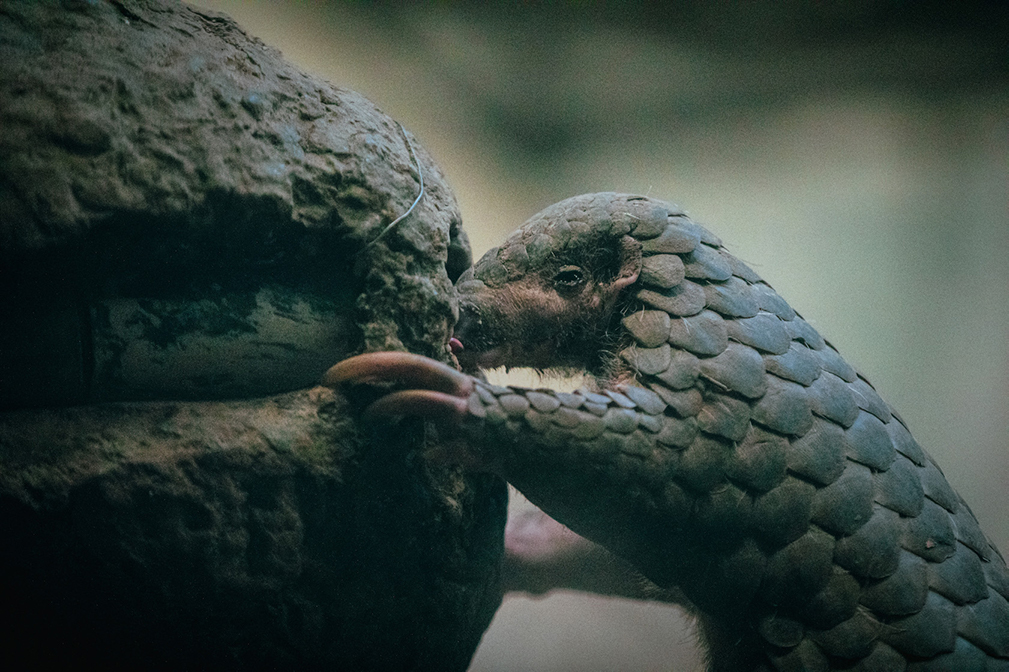
Wildlife experts estimate that nine out of 10 illegally trafficked pangolins are not detected by authorities. Credit: Tsai Yao-Cheng / The Reporter
A global ban on the trade that came into effect in January 2017 did not turn things around. Record numbers of pangolins have been seized so far this year, according to the Environmental Investigation Agency (EIA), an advocacy organisation.
In February, a 30-ton seizure in Sabah, Malaysia, was the largest recorded so far. In April, the Singapore authorities intercepted 12.9 tons of scales, a record seizure equivalent to 36,000 pangolins. A few days later, Singapore confiscated an additional 12.7 tons. In July, another bust led to the discovery of a 11.9-ton shipment, making 2019 a record year.
Global seizures have surpassed the 2018 figures by a wide margin, according to the EIA. Its researchers estimate that an equivalent of 110,182 pangolins has been confiscated by law enforcement this year so far – a 54.5% increase compared with last year.
One reason is the increased awareness by law enforcement, said Darren Pietersen, the director of research and conservation at Tikki Hywood Foundation. “Various research articles suggest that this increase is at least in part a genuine increase in the number of pangolins being poached,” he said.
Nonetheless, the overwhelming majority of smuggling is likely to continue undetected, our reporting suggests. Only a tenth of trafficked wildlife is actually intercepted, according to one Interpol estimate.
Our journalists traced the illegal trade routes from roadside markets in Cameroon and elsewhere to intermediaries and traffickers in Nepal back to China. The following chapters will provide insights into a shadow economy that has thrived out of sight. Without intervention, these actions will drive the animal to extinction.
Despite the scale of the trade, little is actually known about it, even among prosecutors and law enforcement officials in its key market: China.
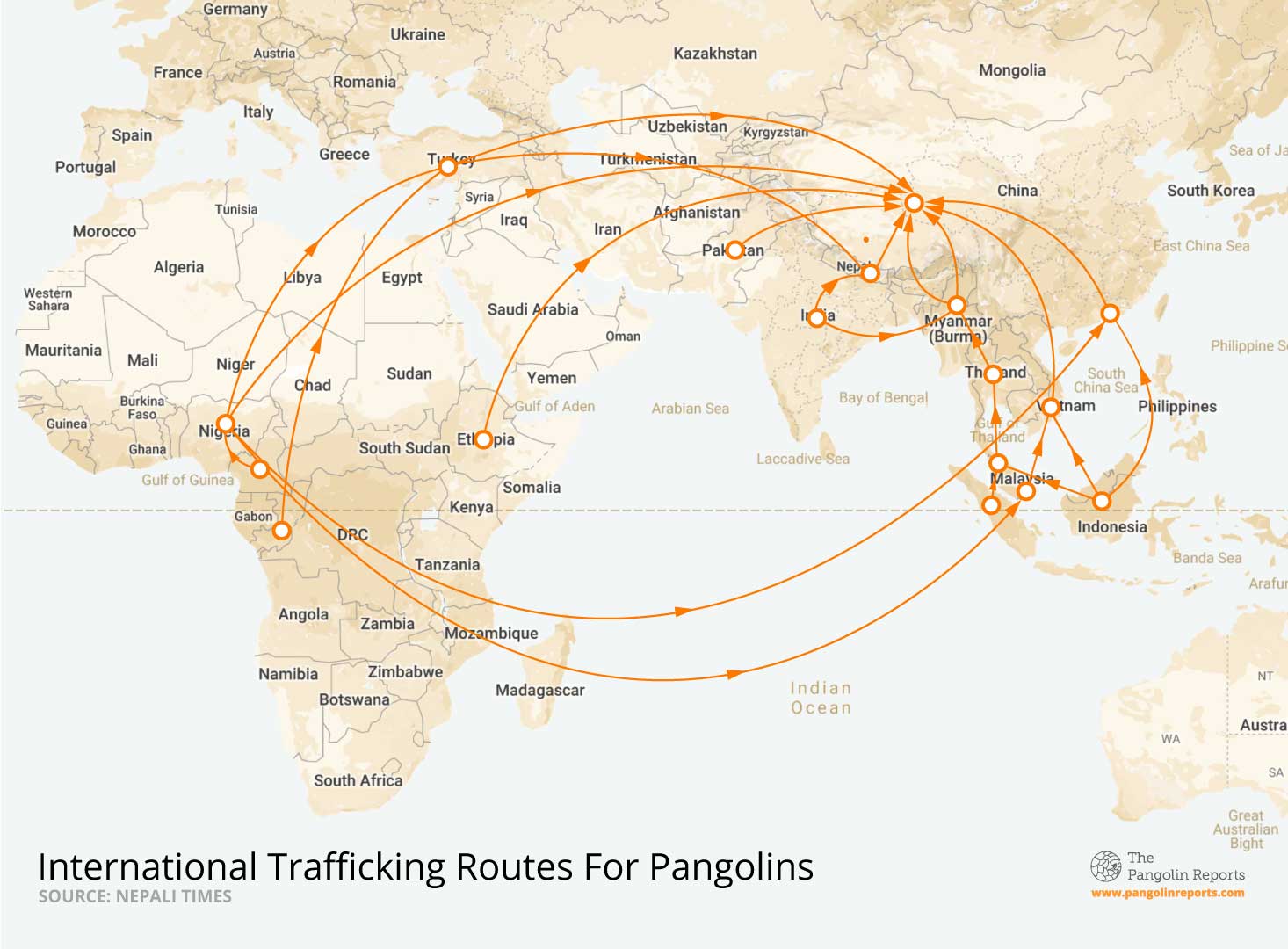
This map depicts the international routes used to traffic pangolins, spanning mostly within Africa and Asia. The majority of demand for pangolins is believed to be from China, where pangolins are consumed and its scales used in traditional Chinese medicine. Data: Nepali Times
Outside the gates of a warehouse in southern China, a middle-aged man surnamed Zhang at first showed no interest in talking to us or answering questions about his business dealings in Traditional Chinese Medicine (TCM).
His mood changed when we mentioned pangolins. “Do you have supply?” he said. “Come to our office, let’s talk about it more.”
Zhang works in the supply department of a TCM producer in Shantou, Guangdong Province. “So far this year, we’ve used several tons of pangolin scales,” Zhang said. “We need at least a few hundred kilograms a month.”
“We ordered a ton of scales last month, but it hasn’t arrived yet,” he said, adding that they would also sell unprocessed scales to other pharmaceutical companies.
Our reporters reviewed more than 400 court decisions in criminal cases in China related to the illegal trade in pangolins from 2005 to 2019. In only a few of the court cases we studied were prosecutors able or willing to retrace the smuggling routes to their origins, like Indonesia and Nigeria.
The numbers of pangolin seizures are rising, not only in China, the primary market, but also in transit hubs such as Vietnam, Singapore and Hong Kong, according to EIA figures. Even there, the origin of the goods remains unknown for the vast majority of cases.
The map shows seizure amounts of illegally trafficked pangolins around the world from 2000 to March 2019. Click on the specific year or adjust the grey bar to view the number of seizures that occurred during that period. Bigger red icons represent larger seizure amounts. Data: EIA
The data is compiled from publicly available records and represents only a fraction of actual trade for that period. Where scales have been seized, the number of pangolins is derived from a mean weight of 5kg of scales per adult pangolin.
Breeding and keeping pangolins has proved difficult. China has an intransparent system that allows for the continued consumption of pangolin stockpiles for TCM. Due to the high demand and limited regulatory oversight, many suppliers rely on cheaper, illegal imports.
Where do these millions of pangolins come from if there are almost none left in China?
This was why we visited Zhang, undercover, at his factory in southern China. We wanted to know where his scales came from.
Zhang insisted that his company was willing to pay a surcharge to source only legal scales, even though they could cost up to twice as much. “Price is not a problem,” he said.
His company, among others, makes TCM concoctions out of raw pangolin scales in industrial quantities. We later reached out to the company, asking them about the origin of their scales. They declined to comment.
But his statements left us curious. If a medium-sized company like his needs tons of scales, where would larger pharmaceutical companies source their pangolin scales? Where do these millions of pangolins come from if there are almost none left in China?
China’s pangolin population has dropped over 90% from the 1960s to 2004 due to massive poaching for its meat as a delicacy and its scales for medicinal use. The Chinese pangolin has been “commercially extinct” since 1995, researchers say.
The profit margins we found are astounding. Scales bought for as little as $5 per kilogram in Nigeria can be resold for up to $1,000 in China, according to traders we interviewed in China. If mixed with legally acquired scales, their price can be as high as $1,800 per kilogram.

Prices of pangolin scales and meat in different countries, sourced from wildlife conservation organisations, government officials, and interviews with poachers and traders, some of which were made undercover.
Who would want pangolin scales? According to some TCM practitioners, pangolin scales can cure a host of ailments, including inflammation and poor lactation in new mothers, and even impotence and cancer.
Dr Lao Lixing, the former director of the School of Chinese Medicine at The University of Hong Kong, said that there is no scientific research that supports the claim that pangolin scales have healing properties.
He said that TCM practitioners in Hong Kong and mainland China have largely stopped prescribing medications with pangolin scales, but pharmaceutical companies have continued to produce drugs with the scales. “It’s a matter of market and profits," he said. "To further the ban on pangolin use in Chinese medicine, we need more public education and concerted efforts by the TCM sector.”
“TCM professionals need to speak up to defend the good name of the Chinese medicine,” said Dr Lao, who speaks regularly at international conferences to advocate replacing animal ingredients in TCM with plant-based substitutes.
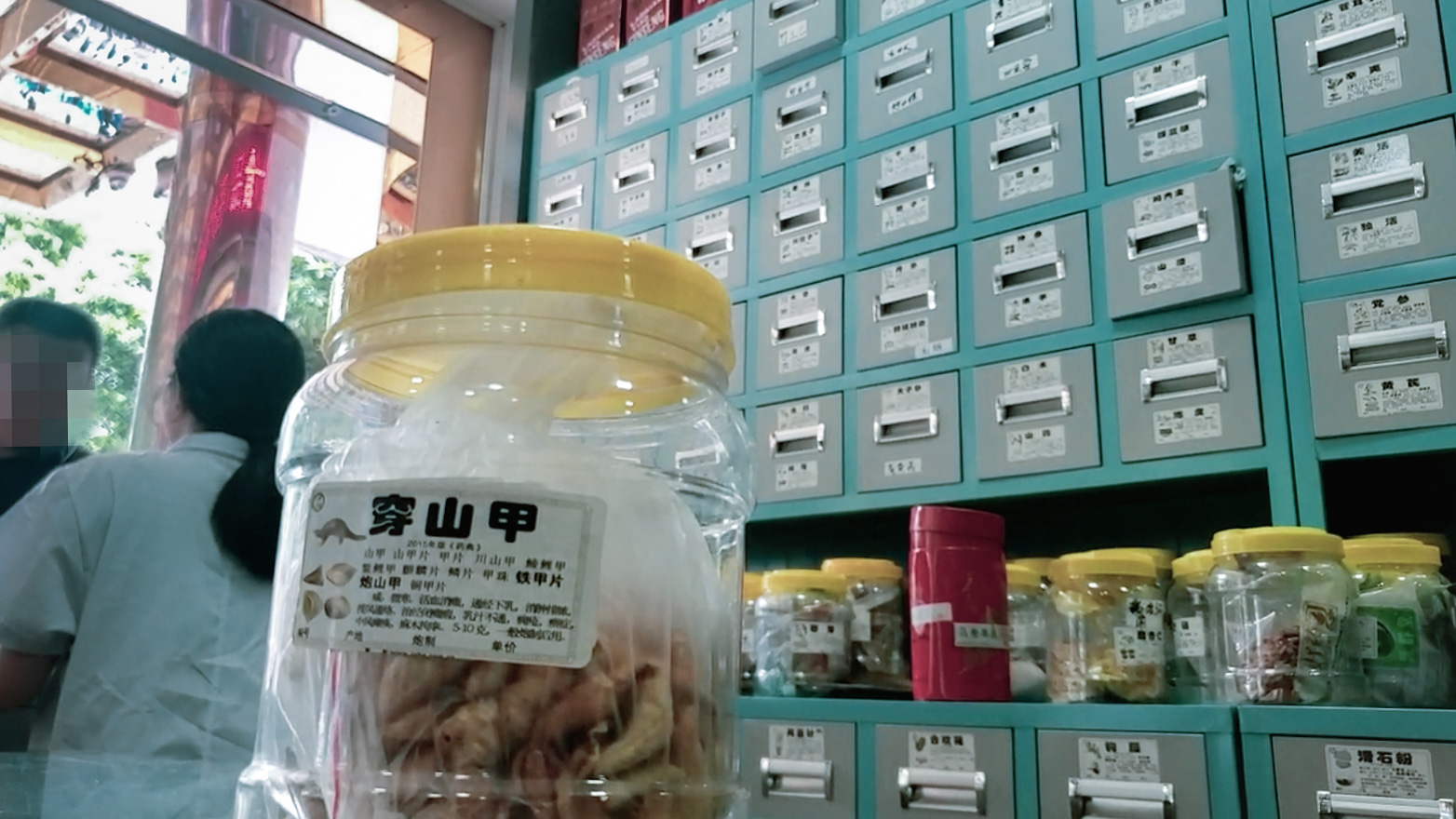
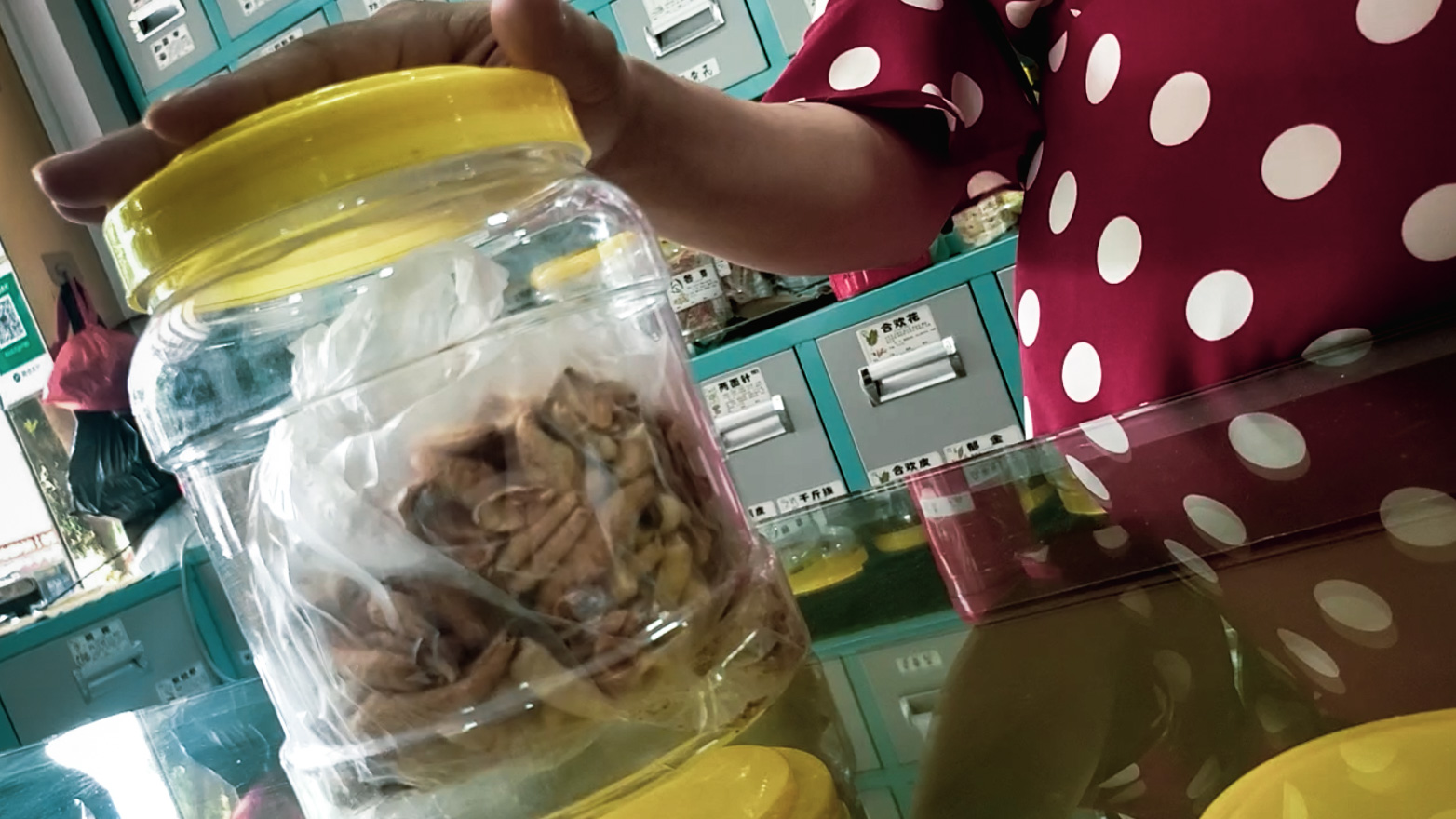
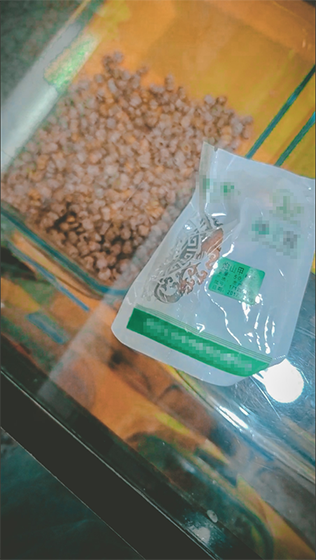
(Left) Pangolin scales for sale at a pharmacy in Shantou, Guangdong Province. These scales were kept in an unmarked plastic bag hidden from the counter, sold for 6 renminbi per gram – that’s less than $1. The worker told our undercover journalist that pangolin scales are good for reducing swelling and promoting lactation.
(Right) In another pharmacy in Shantou, pangolin scales are sold for more than 7,000 renminbi, or $990, per kilogram. This pack contains 5 grams, and is marked with a sticker from China’s Wildlife Special Mark Centre, signifying that it is a legally sold product.
In another pharmacy in Shantou, pangolin scales are sold for more than 7,000 renminbi, or $990, per kilogram. This pack contains 5 grams, and is marked with a sticker from China’s Wildlife Special Mark Centre, signifying that it is a legally sold product.
Although its medicinal properties are unproven, mostly Chinese patients appear to be consuming literally tons of these products. The problem is that we don’t know how much.
“There continues to be a complete lack of transparency on the quantities of pangolin scale stockpiles held by the government or private entities in China,” Chris Hamley, a senior campaigner on pangolins at EIA, wrote in an e-mail. “There is also no information on the estimated quantity of pangolin scales consumed by the Chinese population over a specific time period.”
“The recent string of multi-tonne ‘mega’ shipments of pangolin scales detected by law enforcement agencies in Asia demonstrates that the supply of pangolin scales from historical stockpiles does not meet demand.”
In 2017, Cameroon banned the trade in pangolins. But despite efforts by law enforcement and activists in the Central African nation, we discovered that business is still thriving in plain sight in some rural regions. Pangolin meat can be found in many smaller restaurants along highways and in markets.
A six-hour drive south of the capital Yaounde, in the small town of Djoum, we met a woman named Mango. She runs a bushmeat restaurant, selling wildlife meat including pangolins.
But she is better known for her side business as a pangolin scales trader. She collects pangolin scales in large quantities from other poachers to supply clients in big cities like Yaounde and Douala, who deal with Chinese clients there.
“I know it’s illegal,” she said, “but the business is good.”
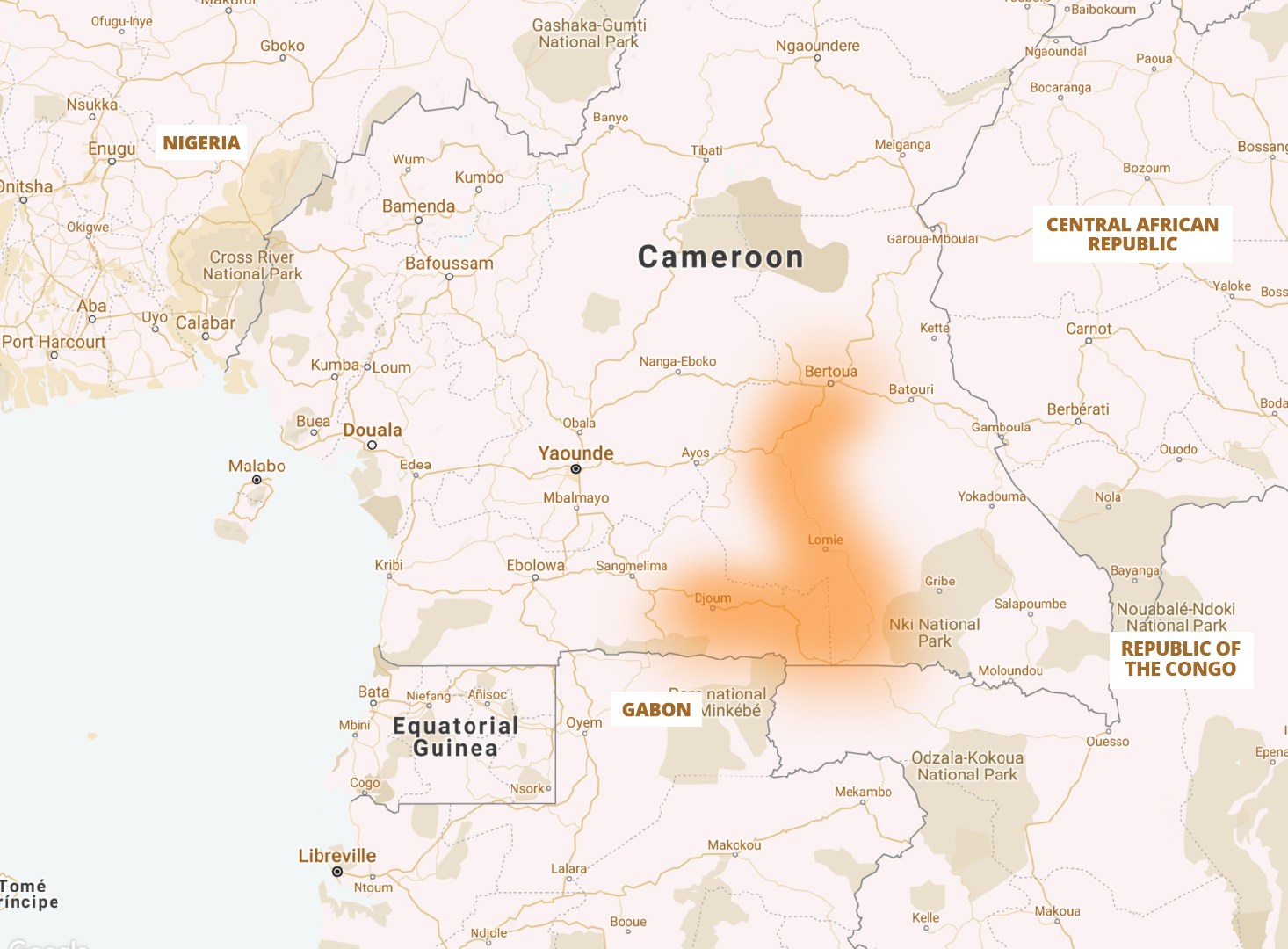
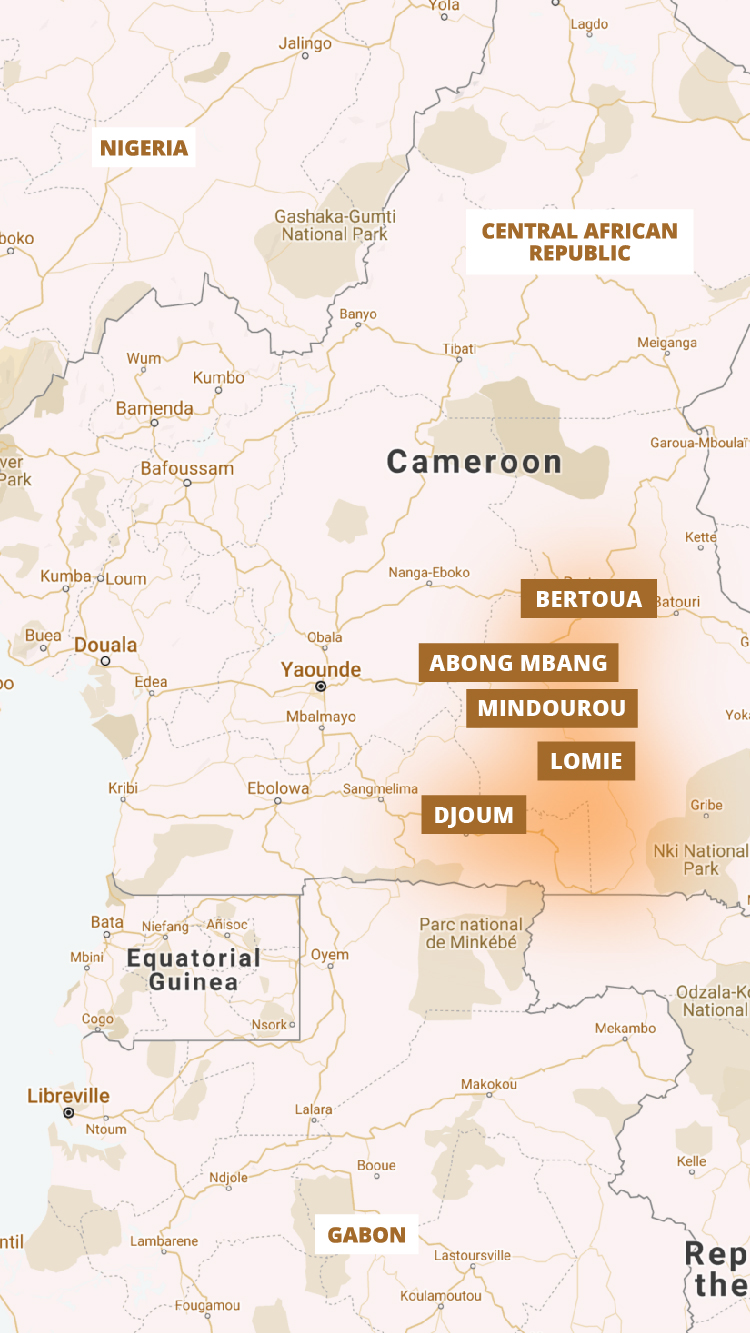
In rural areas of Cameroon, pangolins are still openly traded.
Pangolin scales are sold on to traders in the larger cities, Yaounde and Douala.
Pangolins are then mostly smuggled out of the country via cargo or passenger flights.
At the market, we heard that prices used to be around $5 to $10 per kilogram three years ago. The price has since risen to $15.
Typically, there is a division of labour in poacher families such as hers, according to interviews with her and several of her competitors. Husbands hunt the pangolins and wives sell them on.
Local middlemen roam the region, meeting women like Mango at their homes and buying their catch. They deliver the aggregate to typically Asian businesspeople in bigger cities, who smuggle the produce to Asia, local poachers and wildlife advocates said.
Middlemen hide the scales in trucks that travel along changing smuggling routes to prevent detection by the authorities.
Typically, there is a division of labour in poacher families: Husbands hunt the pangolins and wives sell them on.
“People used to use small vehicles to smuggle pangolin scales from one region to another, but now more are putting scales inside heavy trucks to avoid attraction,” Mango said.
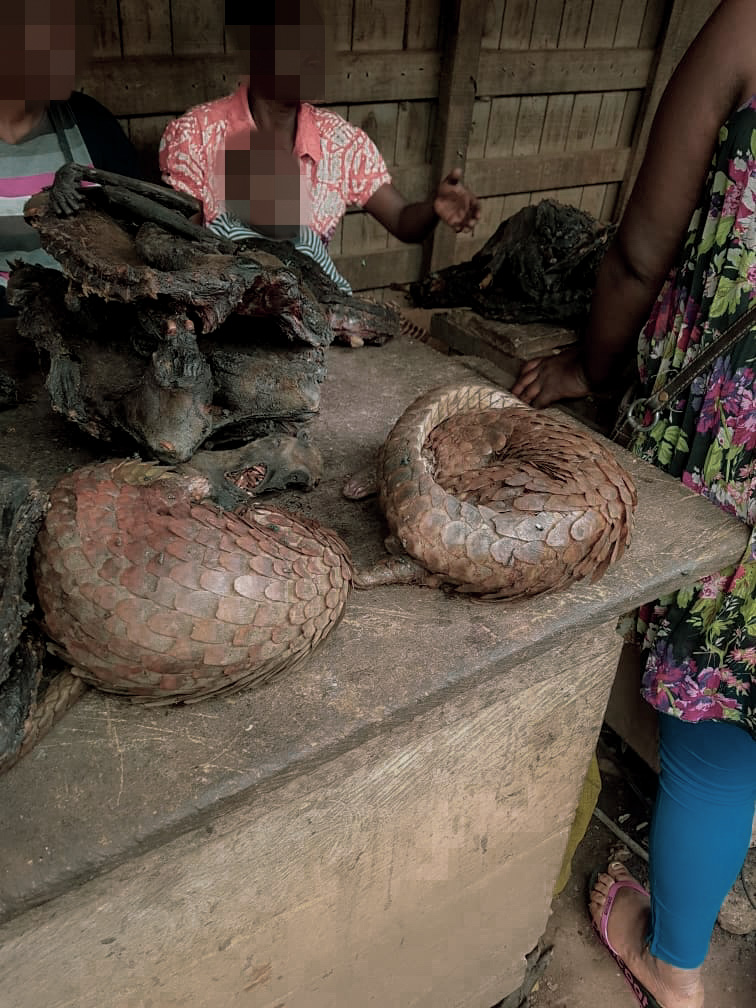
Live pangolins sold at a bushmeat market in Cameroon. Credit: Paul Anu / Green Echoes
With Cameroon’s southern border to Nigeria mostly shut, smugglers now tend to use air cargo shipments. Douala, a city with a sizeable Chinese community, is a favoured spot for smuggling scales out of Cameroon, advocates and local law enforcement said.
After reports of arrests and imprisonments, fewer people are talking openly about the trade.
Increasing demand is taking its toll. In rural Mindourou, we met Danielle, a chef who has been cooking pangolins and feeding travellers along long-distance routes for more than 10 years. She said that pangolins are harder to get, because of the over-poaching.
In the town of Bertoua, a six-hour drive east of Yaounde, we met traders who remain defiant that they will continue with their trade despite the risks of imprisonment. “The killing of pangolins will never stop,” said a woman named Mondi, a trader. “The community depends on the forest for their livelihood.”
The Chinatown in Lagos, Nigeria, has bright red walls painted to resemble the Great Wall, and fluttering Nigerian and Chinese flags. Above the entrance are Chinese characters 中国商城, or “China Business City.”
Chinese-run shops sell everything from clothes to books to machinery. And some suspect, even pangolins.
“I have strong reasons to suspect that some of the scales may be stored there before they are shipped overseas,” said Olajumoke Morenikeji, an environmental biologist and professor at the University of Ibadan.
Morenikeji, former director of the University of Ibadan Zoological Garden, has studied for years how Chinese traders have taken over the market for pangolins because they pay higher prices than their local competitors.
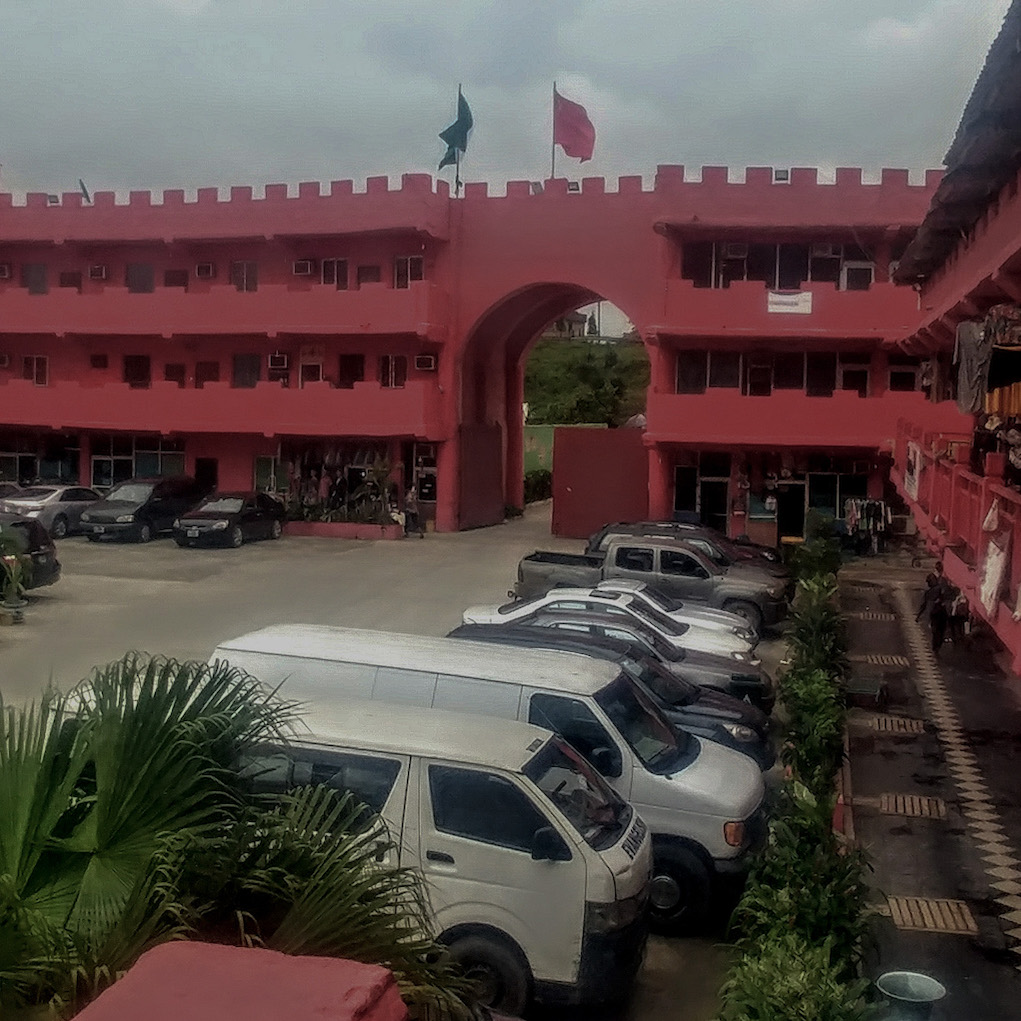
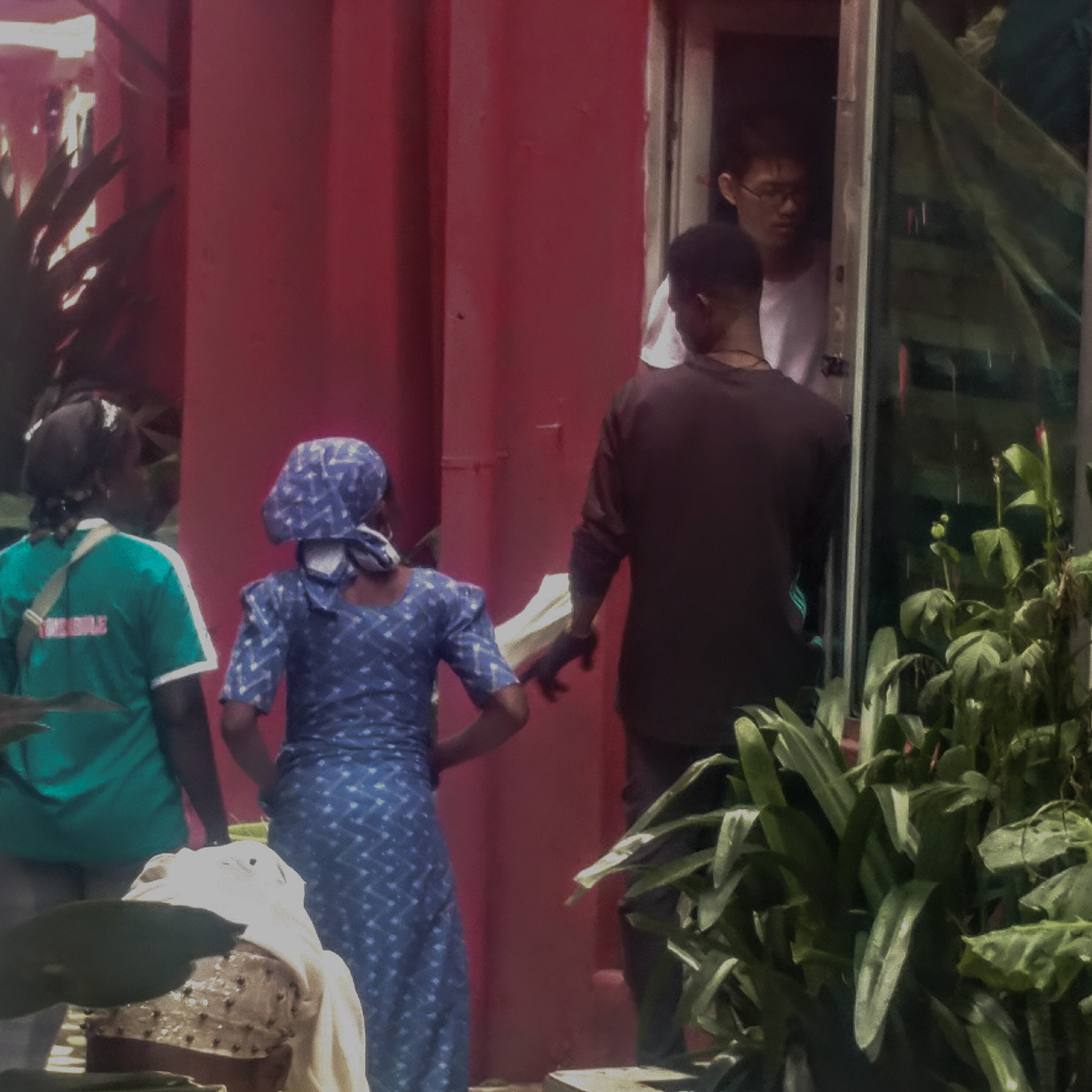
The entrance to China Business City, the Chinatown in Lagos, where predominantly Chinese-run businesses are frequented by both locals and Chinese nationals. Credit: Samuel Ogundipe / Premium Times
She said that local hunters are offered between 5,000 and 10,000 Nigerian naira for a pangolin, or about $14-$28. “That is a lot of money in Nigeria,” she said, adding that local traders are mostly unaware that middlemen profit many times more by exporting it to China.
“The hunters go into the bushes or forests to hunt, usually overnight, and sell to middlemen who know how to get them to the urban markets,” she said. “It is from the urban markets that the Chinese hijack the product by out-negotiating the locals.”
There have been cases in which Chinese traders also go into remote villages in search of the product themselves, she said, referring to an unexpected encounter with a middleman in the nearby town of Ikire.
From Nigeria, the pangolin scales are being smuggled out to China, often via shipping containers that are falsely labelled, leading to large seizures in Singapore and Vietnam earlier this year.
In another recent case, about 120 kilograms of scales were found hidden inside damaged machinery en route to Antwerp, Belgium, according to a local official who was not authorised to speak on the record.
We asked the Nigeria Customs Service about their seizures of pangolin scales. In 2018, they confiscated 6.2 tons of elephant tusks and pangolin scales in 10 busts. Between January and June this year, they seized 667 kilograms of tusks and pangolin scales. They did not provide separate figures.
“Roughly 50 tonnes of illegal African pangolin scales have been seized globally in the last four months,” estimated Peter Knights, the CEO of WildAid, an advocacy group. “In shipments that contain both pangolins and ivory, pangolin scales have now surpassed the volume of ivory.”
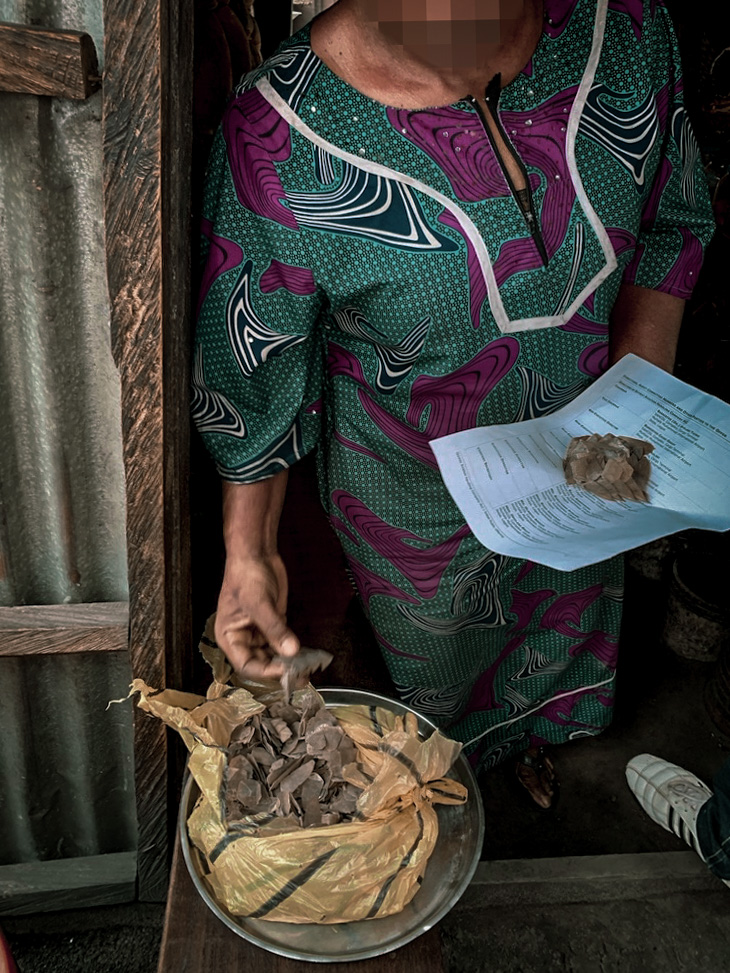
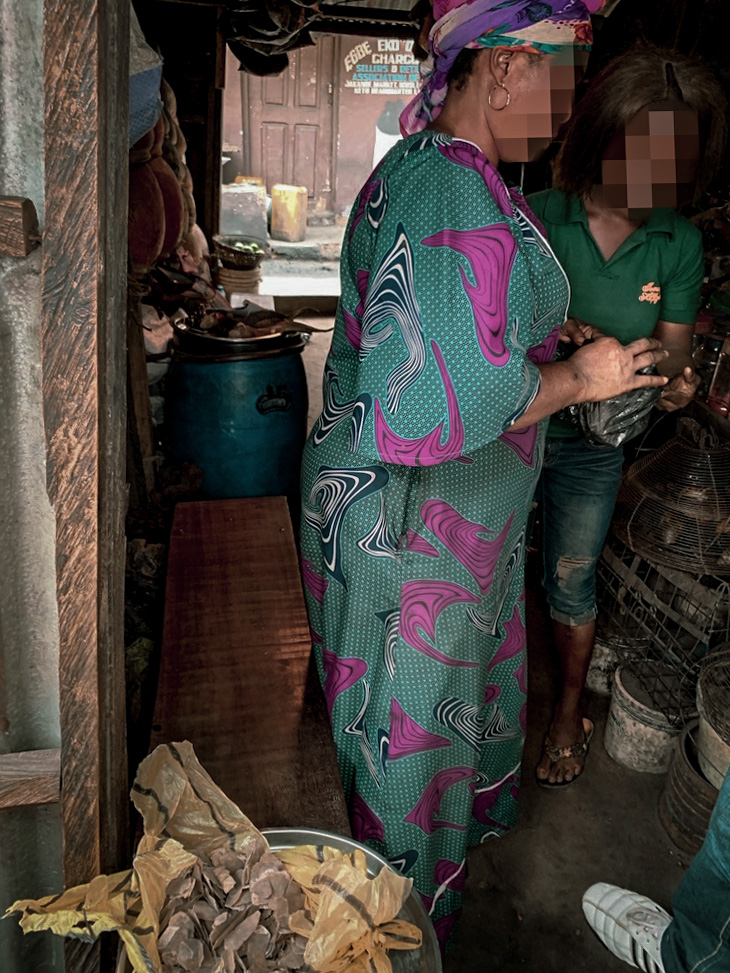
This woman we met at market in Lagos is one of several traders openly selling pangolin scales there. Credit: Samuel Ogundipe / Premium Times
Interviews conducted at local bushmeat markets confirm that growing Chinese demand is displacing local traders. “The Chinco people have taken over the market and are paying high prices to take off all scales from the local market,” said one trader at Ketu Market in Lagos, referring to her Chinese competitors.
When we met her, she had about 1.5 kilograms of scales left in her store, with a selling price of 10,000 Nigerian naira. All the traders we talked to claimed they did not know it was illegal to trade pangolins in Nigeria. “Our forefathers have used pangolins and other wild animals to make medicine and heal people, and we’re not going to stop now,” she said.
“I have been in this business for many years, but I have never heard that it is illegal to sell animals that were caught in the bush.”
“I have been in this business for many years,” said the woman at Ketu Market. “My daughter is now 23, and she was born into it, but I have never heard that it is illegal to sell animals that were caught in the bush.”
At Ijora Market, near the Lagos lagoon, many traders said they have run out of stock in recent months due to Chinese demand. They lamented that the scales no longer reach their markets, but went directly to Chinese buyers.
In a simple bamboo hut in a small clearing among towering rainforest trees, we share a meal of forest squirrel and tapioca with our hosts. They are from the indigenous Temiar community, whose traditional land sits on the northern edges of Peninsular Malaysia’s central forest spine. They are in high spirits, while we are aching with fatigue, because we have just spent half a day hunting and foraging with them.
When they showed us the squirrel that would later become our dinner, dead from a poisoned blowpipe dart, we were told not to laugh or joke. No reason was given, but it struck us as a sign of respect for the utility of the forest and its creatures.
Our conversations with indigenous communities confirm that the demand for pangolins has penetrated even into villages deep in the Malaysian jungle. “In the past, if we felt like eating pangolins, then we will go hunt for it,” said one indigenous hunter. “It’s not like we hunt and eat it all the time.”
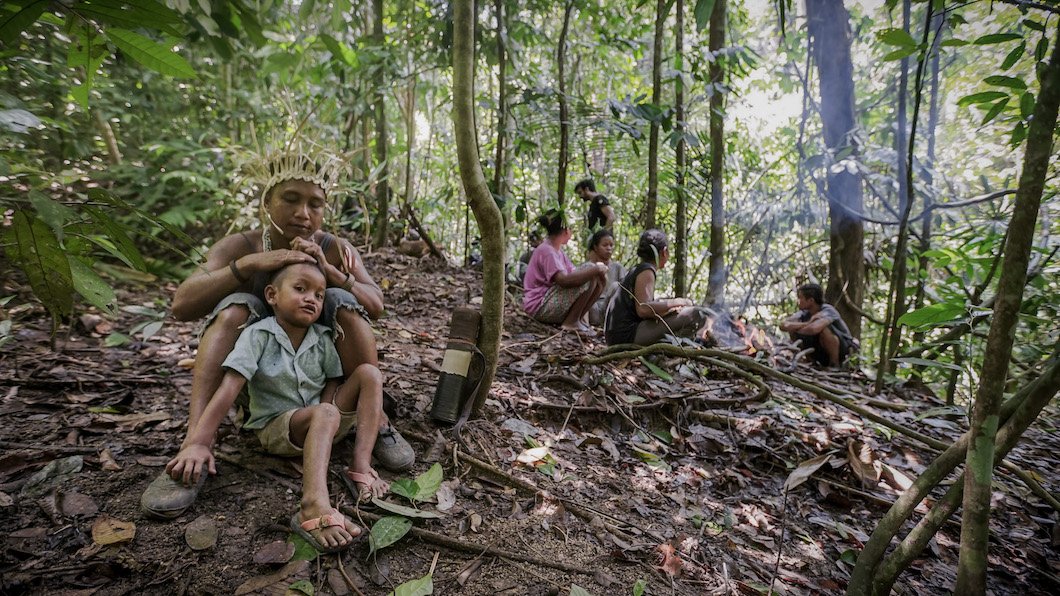
Indigenous communities who live in the forests of Malaysia usually only hunt pangolins when there is a demand from buyers from elsewhere. Prices vary according to buyer and season. They can go up to 600 ringgit (US$143) per kilogram. Credit: Elroi Yee / R.AGE
Among the Temiars, pangolins are said to ward off elephants, an ability they acquired from an incident in which a pangolin wrapped itself around an elephant’s trunk and refused to let go, killing the elephant. Since then, the Temiars say, elephants avoid pangolins. Other indigenous groups are known to link the pangolin to the human foetus, as they believe it is a reincarnation of the human placenta.
The pangolin is an animal so rich in mythology that some villagers we spoke to tell of oral traditions that prohibit its hunting and eating. The hunters we spoke to say they have recently stopped hunting them, despite the loss in possible revenue, citing objections from village elders.
“When there are outsiders who want to buy it from us, that’s when we hunt it and we sell it. If there are no buyers, we won’t hunt it.”
Although these communities mostly live off the forest and have only tenuous links to the mainstream cash economy, the pangolin trade is still influenced by market forces. Different buyers offer the hunters different prices, and it changes by season. Hunters simply try to sell to the highest bidder.
“In the past, prices were around 300 ringgit per kilogram,” said the hunter. “Sometimes, up to 350 ringgit. Even up to 600 ringgit.” That highest price is about $143.
“But now, it fetches around 100 ringgit per kilogram, maybe 150 or 50 ringgit per kilogram. If we hear the price is 50 ringgit per kilogram, we won’t bother. But if we hear the price is 300 ringgit per kilogram, that’s when we go hunting.”
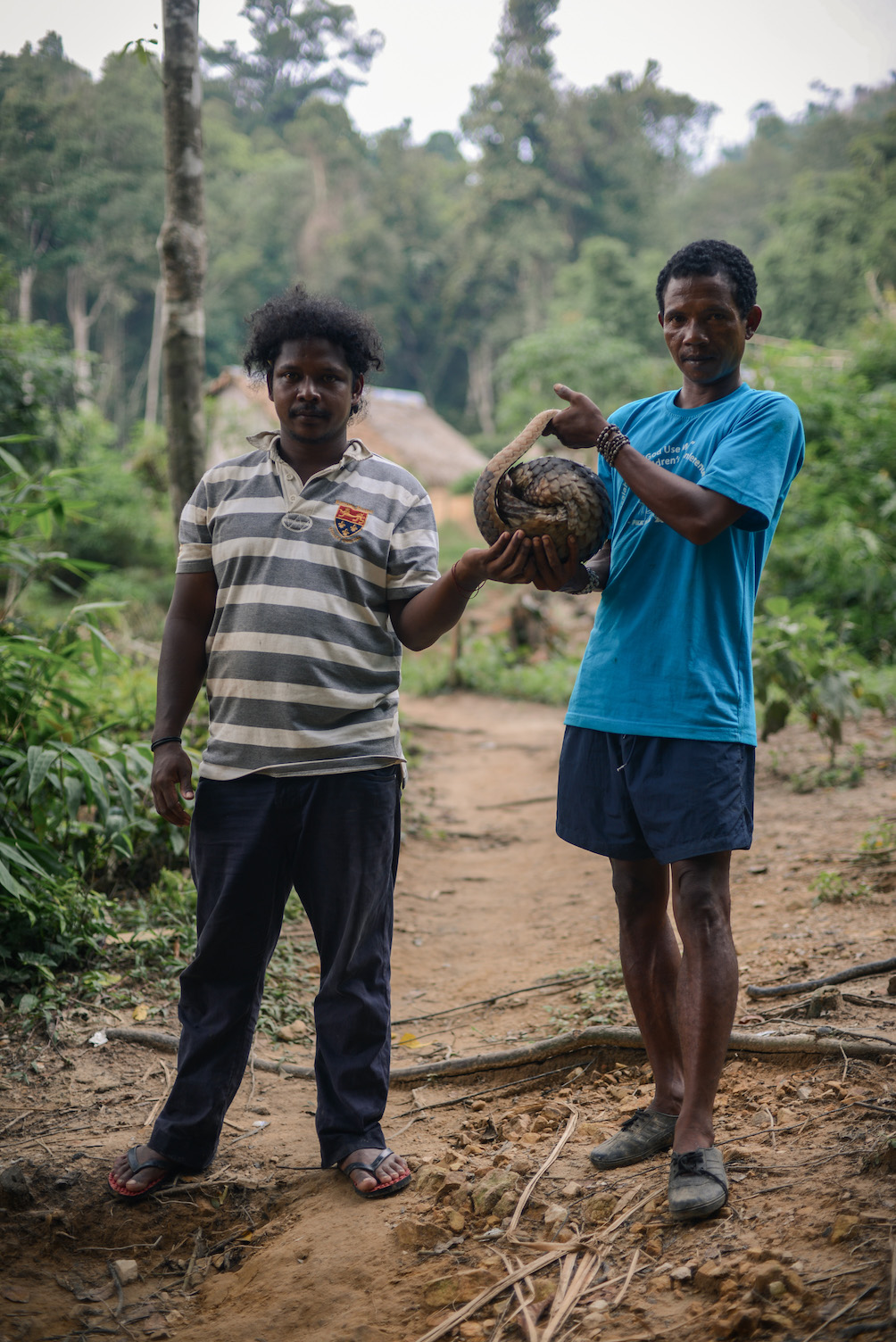
Two hunters from the indigenous Temiar community in Peninsular Malaysia pose with a pangolin they had just caught the day before. While researchers often find pangolins elusive and difficult to study, indigenous hunters' intimate knowledge of the forest and its animals allow them to track pangolins simply by recognising and following its tracks. The pangolin was later released. Credit: Puah Sze Ning / R.AGE
“This demand for pangolins from China first sucked up all the pangolins in China, so that it is now commercially extinct there,” said Dr Chong Ju Lian, a lecturer at Universiti Terengganu Malaysia, who has been involved in pangolin research since 2008.
“Then around 2006 or 2007, we noticed a spike in pangolin seizures in Malaysia. There were a lot of news reports of pangolin smugglers being intercepted by authorities, and bear in mind that the majority of smuggling goes undetected.”
She has found that the demand for pangolins has shifted to African countries, something she and other researchers foresaw when they successfully lobbied for all eight pangolin species to be reclassified under Appendix I in the International Union of Conservation and Nature’s (IUCN) trade list, a move that bars all commercial trade of pangolins.
“That’s why we insisted on including the four African species in the reclassification, even though they were not considered critically endangered back then.”
“When there are outsiders who want to buy it from us, that’s when we hunt it and we sell it. If there are no buyers, we won’t hunt it.”
Based on her conversations with indigenous communities, Dr Chong said she thought that poaching has brought Malaysia’s pangolin population to the brink of extinction.
“Some indigenous hunters say they have not seen a pangolin in three years,” she said. “The middleman is still willing to buy, but pangolin hunting is just not as attractive now as it used to be, simply because it is so difficult to find one.”
Next to a roadside food stall, sparse nighttime traffic whizzes by. Everything is tinged orange by streetlight. We are in Malaysia, a 40-minute drive south of the Thai border.
The pangolin smuggler we are meeting undercover arrives with his daughter, a child no older than six. It is a scene that is difficult to reconcile – she, dressed like a princess, complete with a tiara. He, a smuggler of pangolins and who knows what else.
"OK, let me explain," he said. "The goods come from Indonesia, and the towkays, they bid for the goods." He uses the colloquial term for buyer or “boss.”
"Goods from Indonesia, it must be at least a ton. So, one ton of goods and the bidding starts. Price starts at 300 ringgit per kilogram. Okay, how much can you pay?" He motions towards one of us. "OK, this one wants to pay 310 ringgit." He motions to another one of us. "Now this one wants to pay 320 ringgit. And another one wants to pay 350 ringgit."
"So the one who offered 350 ringgit will get the goods." (The price he cites equals $84.)
Over four months, we spoke to several people involved in wildlife smuggling like this man, ranging from smugglers to middlemen to poachers. Some interviews were made undercover, in which we claimed to be traders. The interviews show that the underground pangolin trade has matured into an illegal, but open market. Competition is fierce, and market forces decide on prices. Innovation differentiates those at the top.
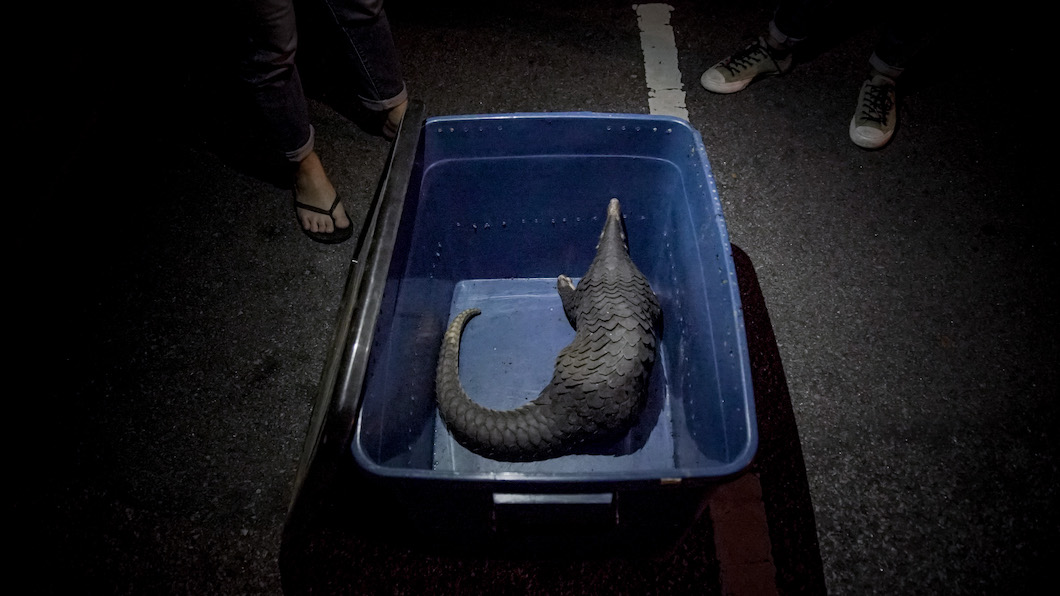
A pangolin rescued from an online wildlife trader during our undercover investigation. The pangolin was later released into the jungle by the Department of Wildlife and National Parks Peninsular Malaysia.
Overwhelming demand for pangolins is driving an illicit trade that often slips past local law enforcement. Sometimes the reason is corruption, as evidenced by this man before us, who is not only a smuggler, but also a policeman. He asked not to be identified.
We had met him earlier at a magistrate courthouse, where he was standing trial for possession of 81 live pangolins.
According to the policeman-smuggler, the pangolin market is so competitive that syndicates are double-crossing each other to gain an advantage.
"So the one who offered 350 ringgit gets the goods, but the others know that the goods are arriving,” he said. “They might not know when exactly, but they know it is coming this week, or in two, three days' time. So they are ready."
By "ready", he means they are ready to sabotage the trader who won the bid. According to him, that is how he got caught. Someone from a rival syndicate leaked information to wildlife enforcement officers.
"When the goods are available, they already have their target," he said. "In fact, I have sabotaged someone from their team before."
Sources close to ongoing investigations say that the market is price-driven, and the syndicate that pays the highest can dominate the market.
Investigations show that live pangolins from Indonesia typically enter by boat, landing along the coast of the Malacca Straits, before being transported northward by car across the Thai border.
According to the policeman-smuggler, the pangolin market is so competitive that syndicates are double-crossing each other to gain an advantage.


The Malacca Straits is a key smuggling route for pangolins. Smugglers and sources within enforcement agencies say that batches of live pangolins are typically shipped on small to medium-sized boats, landing at hidden locations along the Malaysian coastline.
Pangolins are also sourced from Malaysian jungles or plantation areas.
Pangolins are brought together at collection points, before being transported to Thailand. From Thailand, pangolins are smuggled on to Laos, then to Vietnam and China.
There, growing demand has changed the nature of the trade. Customs officials have become more aware of the trade, forcing smugglers to become more sophisticated. Smugglers crossing the border used to hire lorries, but are now increasingly using less detectable passenger vehicles, said Somkiat Soontornpitakkool, director of the Wild Fauna and Flora Protection Division of the Department of National Parks, Wildlife and Plant Conservation in Thailand.
This is corroborated by the enforcement authorities in Malaysia, who have shown us photos of passenger cars being outfitted with special air conditioning vents channelling cool air into the boot of the car. This keeps pangolins alive longer during the smuggling run.
The smugglers want to keep the pangolins alive because they can fetch higher prices for the meat. Often, we’re told, customers prefer to see the animal alive at restaurants. One restaurant chef we spoke to, who used to serve pangolins to tourists from China, said the usual practice was to slit the pangolin's throat in front of the customer, then use its blood in the cooking.
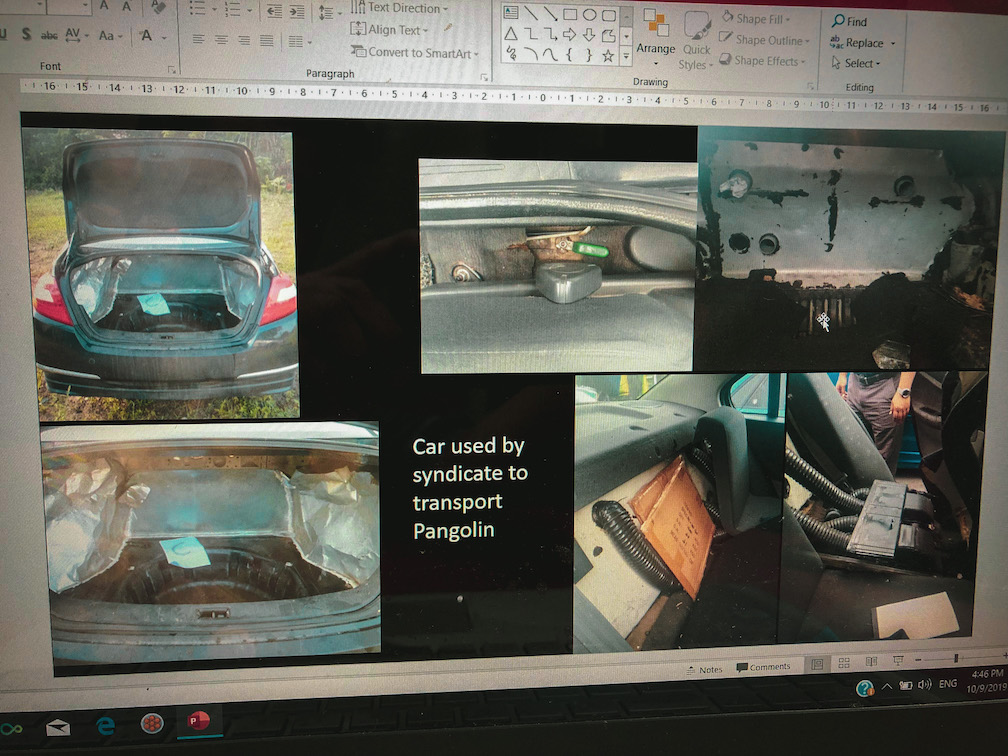
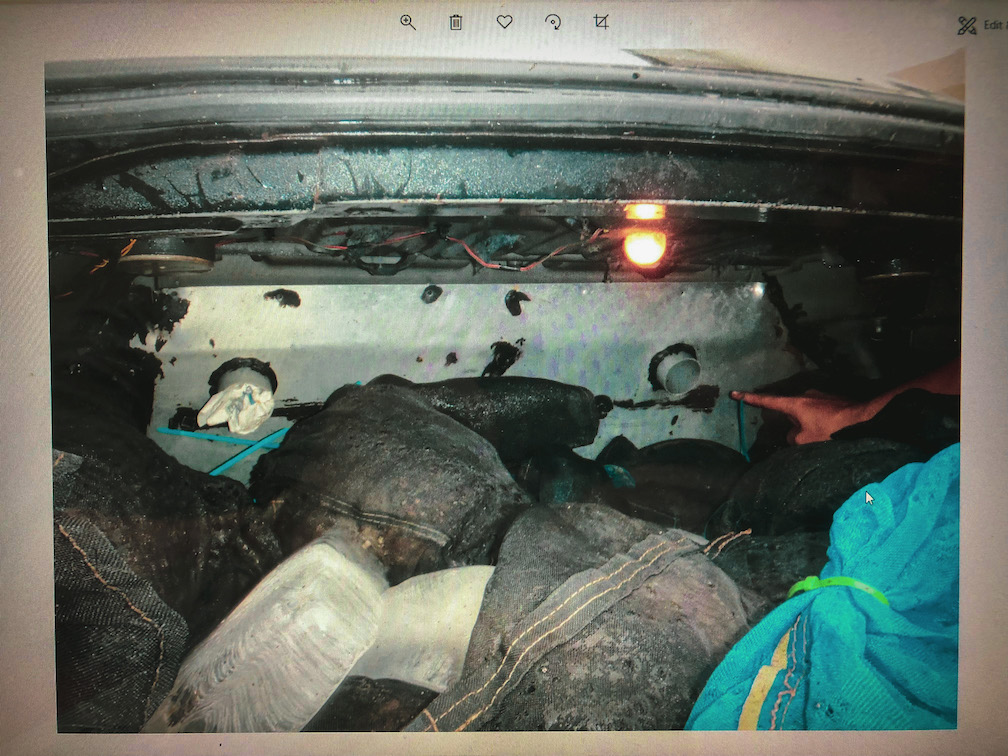
Syndicates smuggle pangolins in passenger cars outfitted with special air conditioning vents in the boot to keep the animals alive longer. © Department of Wildlife and National Parks, Malaysia
“The smuggling routes mainly lead to the provinces adjacent to the Mekong River in northeast Thailand – Nakorn Phanom, Mukdahan, and Nongkhai – before going to Laos, and then on to Vietnam and China,” said Somkiat.
Near the border, professional smugglers are hired to send the goods across the border. Investigations show that members of the police and other enforcement authorities are involved. Since 2012, three Malaysian policemen have been arrested for smuggling pangolins, including one officer who was arrested twice. All three worked, or are still working, at the same police station, the Kedah state police headquarters.
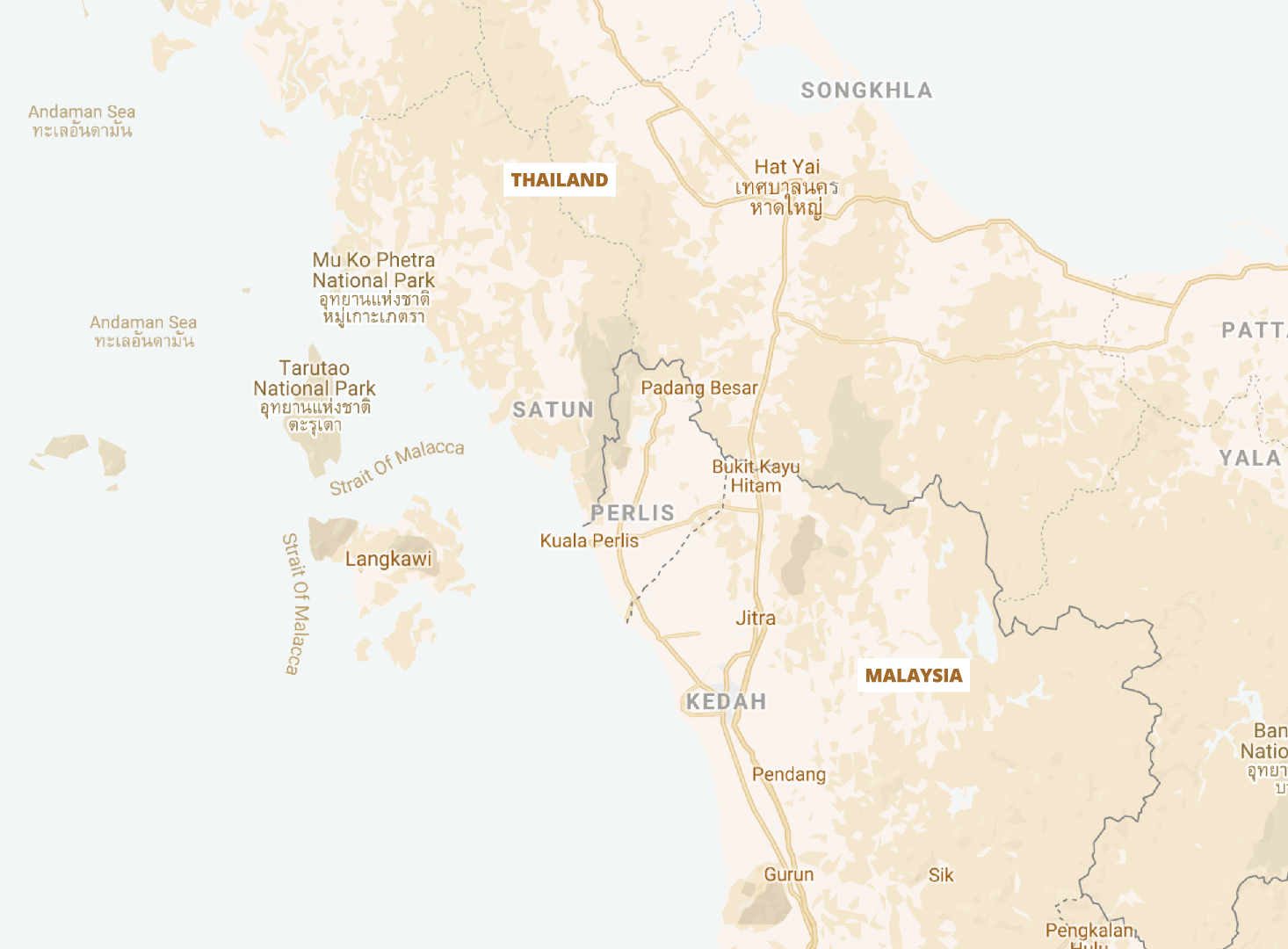
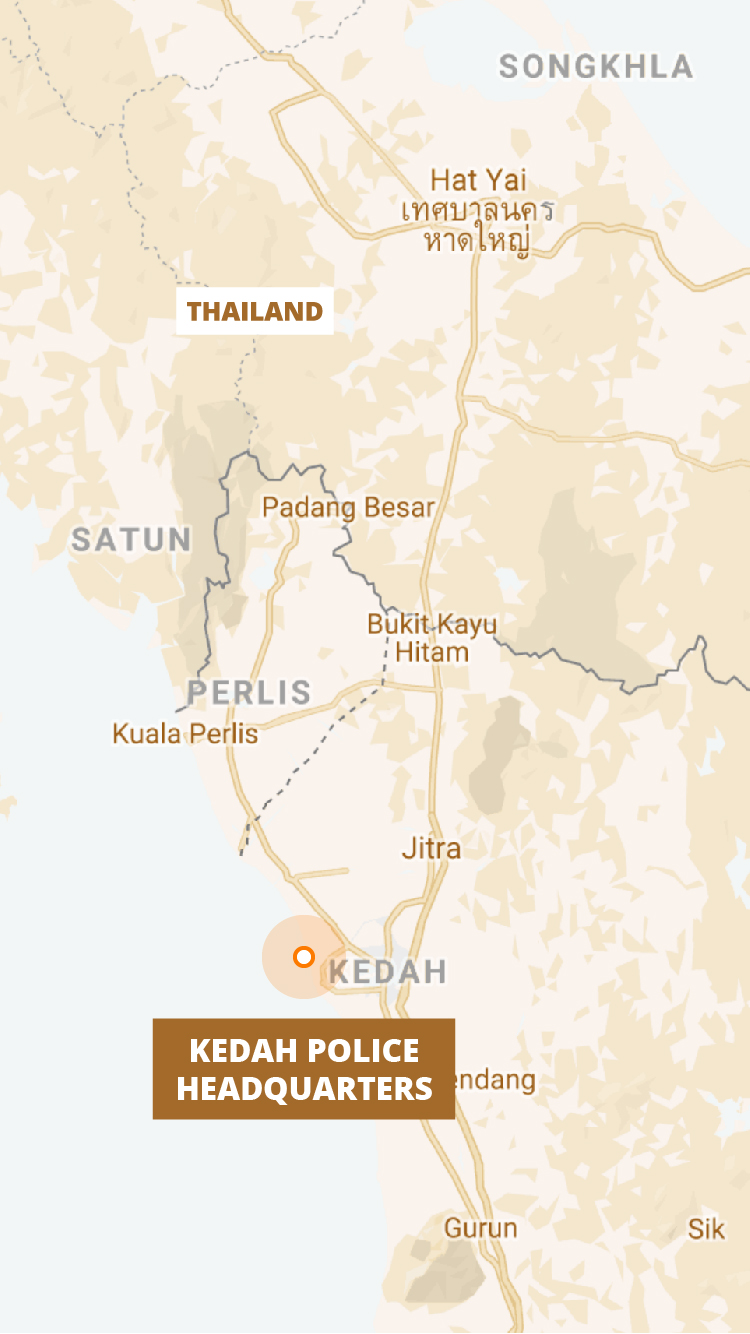
Sept 2012 : Police officer Mohammad Norazzuan Ahmad Zahari arrested at an unspecified location in Kedah State, likely near the border, in possession of 18 live pangolins.
Nov 2014 : Police officer Mohammad Norazzuan Ahmad Zahari arrested again on at the Bukit Kayu Hitam border checkpoint; 43 live pangolins were found in the boot of his car.
Sept 2018 : A police officer was arrested with 81 live pangolins in a house rented under his name. The trial is still ongoing.
Feb 2019 : Police officer Ahmad Nasrul Hafifi Mohamad arrested at Sadao customs checkpoint, after passing Malaysian border checks, with 47 pangolins found in his car.
All three police officers worked at the Kedah state police headquarters. Investigations suggest that there is a larger smuggling ring run by members of the police and officers from other enforcement agencies.
We were shown evidence by a government source that links some 12 enforcement officers to the pangolin trade, suggesting that there is a wider network of corruption.
These officers range from traffic cops to high-level border control officers, and the majority are based in the northern state of Kedah, bordering Thailand.
“We are taking this seriously,” says Kedah police chief Zainuddin Yaacob, when asked about evidence of corruption within his ranks.
“If [police officers] are charged or convicted, then we can take action by suspending them from duty. If they are convicted under criminal charges, then there is no option but to discharge them from service.”
While most live pangolins passing through Malaysia now originate in Indonesia, syndicates also used to source them from Malaysian forests.
“In the past, I was moving a lot of stock, hundreds of baskets,” boasted one pangolin trader. “I’m not lying to you, at least three tons a month, delivered right to my doorstep.” The trader is a middleman who previously sourced pangolins from indigenous communities living in the forest. He claims to have left the trade after being caught in 2014.
“There is less stock in Malaysia now, so they rely on Indonesian stock,” he said.
Over in Sabah, in East Malaysia, a pangolin- smuggling syndicate has the distinction of being the only known syndicate to deliver processed frozen pangolins.
A raid in February 2019 in Kota Kinabalu, Sabah, at two premises run by the same syndicate led to the discovery of a total of 27.9 tons of descaled, gutted, frozen pangolins in huge freezers. A further 361 kilograms of pangolin scales made the seizure the largest pangolin seizure ever recorded.
While most live pangolins passing through Malaysia now originate in Indonesia, syndicates used to source them from Malaysian forests.
The way in which the pangolins were being packaged makes it likely they were meant for export, probably to China, a source familiar with the ongoing investigation said.
And there are signs that this syndicate has been operating for years.
In 2010, a Malaysian man was arrested on the coast of the southern Chinese port city of Zhuhai over the shipment of nearly 10 tons of frozen pangolins and pangolin scales on a fishing vessel. He was sentenced to life imprisonment, which was later reduced to 19 years due to good behavior. Four crew members of the ship, all of whom were Chinese nationals, were handed five- to 10-year sentences.
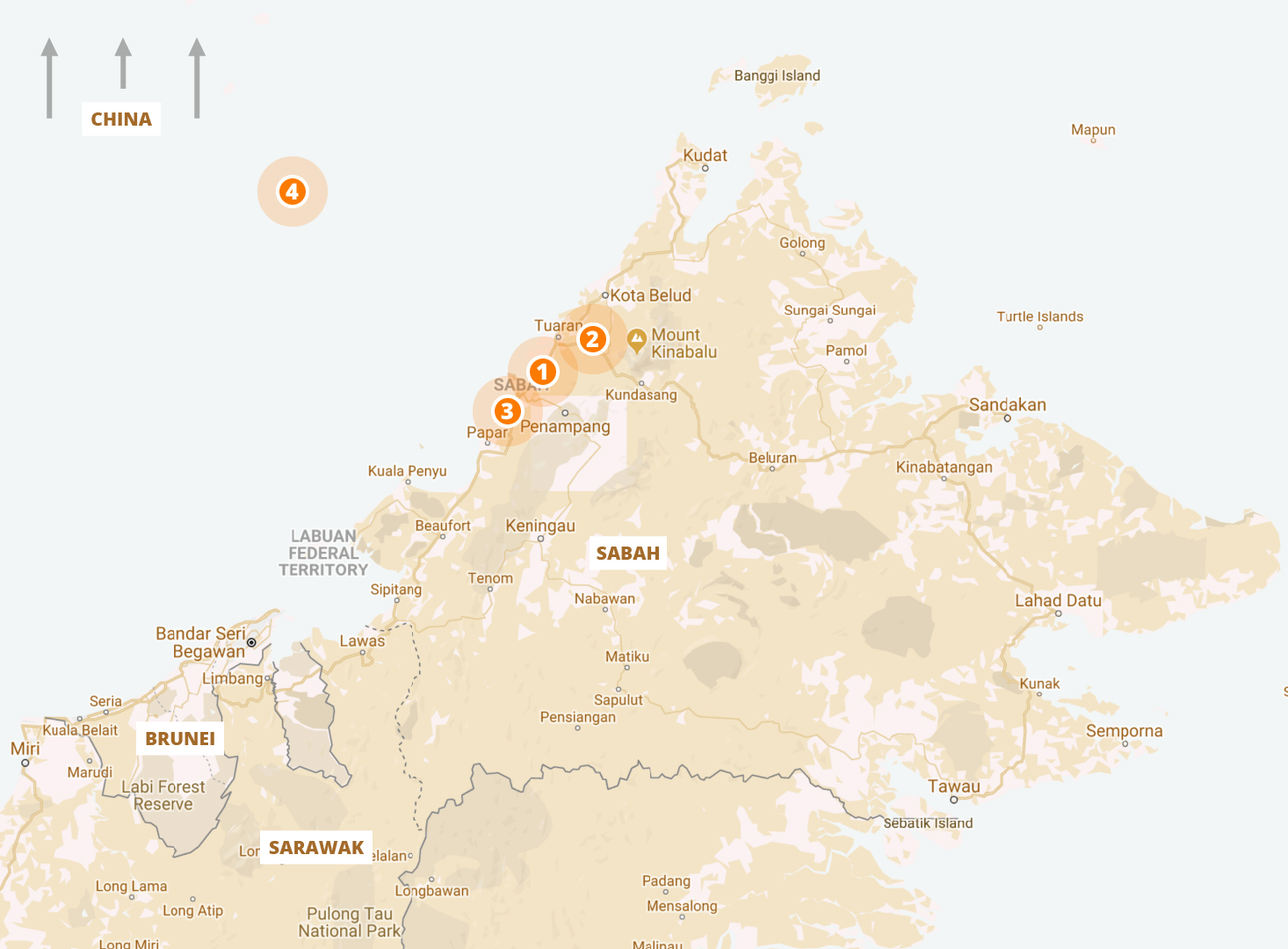
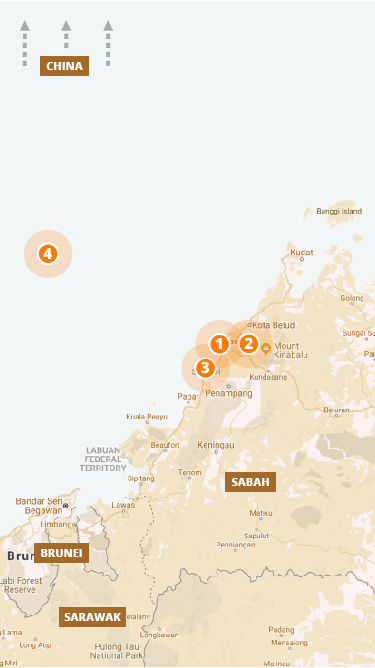
1 & 2 A February 2019 bust found almost 30 tons of frozen pangolins and pangolin scales at these two locations. Sources indicate that the pangolins were likely meant for export by ship from 3 Sepanggar Port to China. 4 Location where the Chinese authorities suspect pangolins were taken to a shipping vessel that was subsequently seized in Guangzhou, in a 2010 case. These coordinates were found on the phone of a smuggler imprisoned in China.
Investigations showed that the man's mobile phone contained a set of trade-related coordinates, including one pinpointing a location off the coast of Sabah, near Sepanggar Port in Kota Kinabalu. It is the same port area where the record seizure took place in February 2019.
Interviews with the man’s wife confirmed that he was involved in pangolin smuggling, and that he was based in Kota Kinabalu.
She insisted that her husband was not the mastermind behind the operation and that he was merely working for a syndicate helmed by a prominent businessman involved in the “frozen seafood business.”
People familiar with the inquiry said that the police are still investigating whether the same syndicate was behind the 2010 and 2019 cases.
Seized pangolin scales and meat. Money transfers. Shipments to China. Tip-offs. These are the hints that point to a network of pangolin smugglers in Indonesia. Denials. Silence. Lack of direct evidence that could turn unusual coincidences into bulletproof evidence. These are the challenges faced by law enforcement, and us as we investigated the pangolin trade in Indonesia.
A review of court records, dozens of interviews with poachers and the police have provided the clearest indication yet that the pangolin trade in the archipelago nation has professionalised. It has become so sophisticated that it reminds experts of the drug trade.
In Sumatra, Java and Kalimantan, pangolins provide an essential balance to the ecosystem, feeding on pests which affect plants such as the oil palm. However, syndicates in these areas “hunt on a massive scale during the transition from rainy season to dry season,” Sustyo Iriyono, the official at the Environment and Forestry Ministry in charge of fighting the illicit pangolin trade, said in an interview.

The Malacca Straits has become a hotspot for pangolin smuggling heading to Malaysia. An analysis of cases reported in the media reveals a consistent modus operandi: transporting live pangolins across the Straits on smaller vessels.
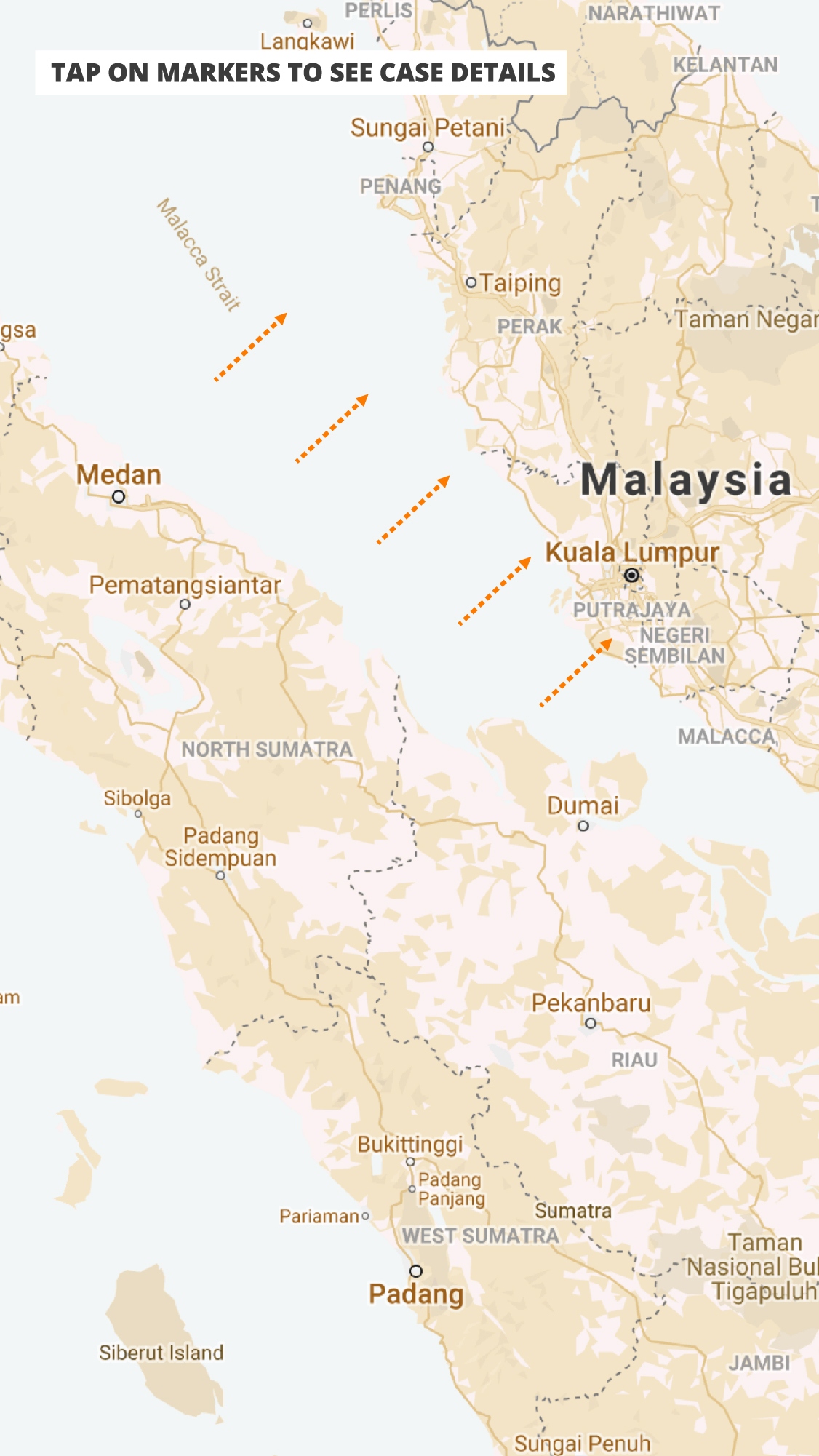
102 pangolins seized - Nov 2015
102 pangolins were seized here, as smugglers were about to transport them to Malaysia via the Melaka Straits. Nine of the pangolins had died.
128 pangolins seized - Feb 2013
Belawan Customs and Excise Office (KPPBC) marine patrol team seized 128 pangolins as they were being smuggled out towards Malaysia, via the Melaka Straits.
Over one tonne of pangolins seized - June 2017
Over a ton of live pangolins, pangolin parts and scales were seized at a warehouse here. The stash included around 225 individual pangolins, five large sacks of wet pangolins, and four large sacks of dried pangolin skin.
102 pangolins seized - 2013
102 live pangolins seized at the Port of Batubara Regency, onboard a ship. The ship's captain and four crewmembers were arrested. The captain admitted that he was instructed to transport the pangolins to Malaysia.
May 2014
Two persons were arrested while attempting to smuggle four pangolins to Malaysia by ship, from the Tanjung Balai Port.
101 pangolins seized - 24 Oct 2017
101 pangolins seized by navy personnel as they were being smuggled to Malaysia via boat.
89 pangolins seized - Unspecified date
Police thwarted a plan to smuggle 89 pangolins to Malaysia. Four people from South Sumatra were named as suspects. The pangolins were transported by land with two cars to a small port on Bengkalis Island, where they were to be smuggled out to Malaysia via boat.
The Malacca Straits has become a hotspot for pangolin smuggling heading to Malaysia. An analysis of cases reported in the media reveals a consistent modus operandi: transporting live pangolins across the Straits on smaller vessels.
TAP ON MARKERS TO SEE CASE DETAILS
Here, investigators typically aim for the poachers and then try to work their way up the syndicate through vendors and middlemen. Rarely do they get very far.
The premiums on the trade leave plenty of room for middlemen. In Indonesia, a poacher might get around $20 for a kilogram of pangolin meat. The same meat could sell for up to $1,200 elsewhere. The value of pangolin scales multiplies 30-fold along the supply chain.
Sustyo estimates that Indonesia is the world’s largest illicit exporter of pangolin meat and scales, even though pangolins in Indonesia cannot compete with the African subspecies in terms of size. Shipments mostly go to China, sometimes through Vietnam and Hong Kong.
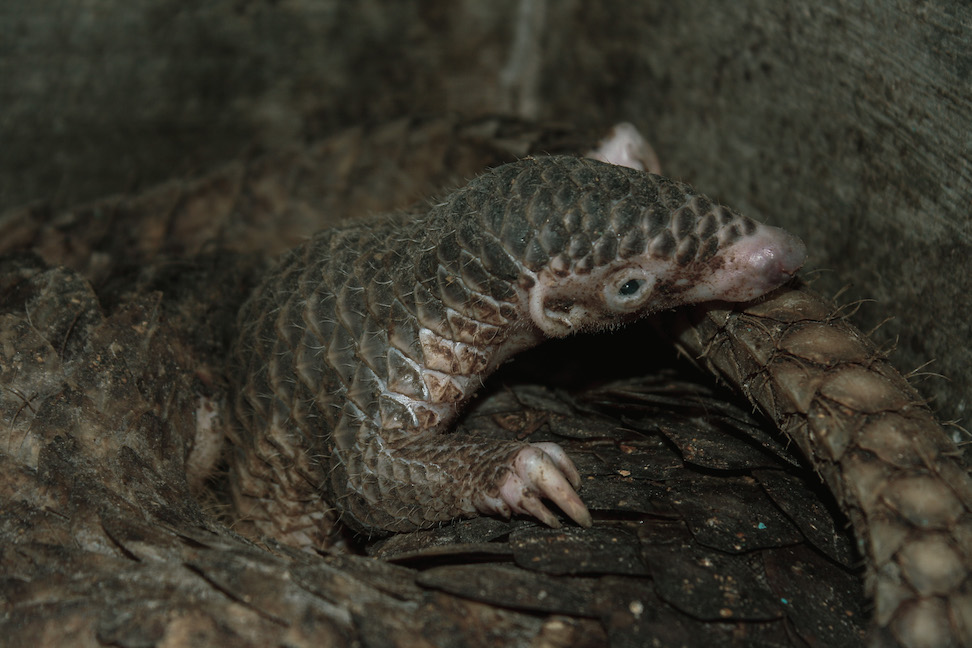
A Malaysia-bound baby pangolin that was rescued by police in Medan, Indonesia. Dozens of pangolins seized in the same bust were later released into the wild. Others were given to the Indonesian Institute of Sciences for research. Credit: Tommy Apriando / Tempo, Mongabay
Asked about the smuggling routes, he said that the trade networks have become “well organised.”
“In the past, smugglers used cargo planes,” he said. “After this was discovered, they began altering the manifests of shipping containers. Pangolins are hidden among export commodities such as dried squid and fish. Some evade detection by going through small ports, where fishing boats are involved.”
We retraced some recent seizures near Medan, Sumatra’s largest city, and found indications of an extensive trade network.
The port city is already known as a major smuggling hub. Police Brigadier General Dedi Prasetyo, a national police spokesman, told us that Medan in northern Sumatra, Surabaya in eastern Java and Pontianak in western Kalimantan are the most significant transit locations for pangolins. They are often concealed in frozen fish, squid and oysters, Dedi said.

Medan, one of Indonesia’s largest transport hubs, is often used as a port of exit for pangolin smugglers.
Several seizures and court cases point to a network linked to a man called Robert Ongah. Also known by the nickname Atiam, he could not be reached for comment despite several attempts.
“I represent Pak Robert,” said an employee of an alcoholic beverages maker in Jakarta, using a deferential term. “He has no comment, and all of the questions in the interview request are wrong.”
Ongah is the owner of Tetap Jaya, a frozen fish export company, with an office in Medan, among other ventures. He also controls other enterprises, including the brewer, where we reached an employee in Jakarta. Police officers told us that they traced at least 50 billion Indonesian rupiah, or about $3.5 million, of transfers from suspected intermediaries to him.
More than half of these funds were traced coming from Ongah’s accounts going to the account of one Edy Soerja Susanto, police said. These funds then reached wildlife dealers who were later arrested.
It is unclear whether Edy is being investigated. Reached by phone, he denied involvement in the pangolin trade. “I don’t know Robert Ongah,” he said, before ending the call.
The network appeared even wider and tied to other, more sinister, crimes, investigators told us. Dian Ediana Rae, the deputy chair of the Financial Transaction Reports and Analysis Centre, said some transactions linked the network to the notorious convicted drug lord Togiman.
Togiman has been sentenced to death twice, in 2016 and 2017, for various narcotics cases, including for continuing his operations behind bars. His bank account balance: 6.4 trillion rupiah, or $458 million.
In July 2019, a Philippine court convicted three men of violating the country’s wildlife protection law. They were caught in possession of 10 Philippine pangolins, a domestic subspecies, at a checkpoint in Tagaytay City, Cavite, some 60 kilometres south of the capital Manila.
While the case was called the first successful conviction of wildlife traffickers from Palawan – where the Philippine pangolin is endemic – the penalty for the crime was light. The court sentenced each poacher to three months of imprisonment and a fine of 20,000 pesos, or about $385. In August, the three men posted bail and filed a petition for probation.
Emerson Sy, executive director of the Philippine Center for Terrestrial and Aquatic Research, said that given such penalties, the law itself is not a deterrent to poachers.
“What’s noteworthy is that the same people are involved [in the illegal trade]. For example, one main buyer who is a foreign national has already been caught many times but still operates. Because the penalty in illegal wildlife trade – it’s bailable – if a poacher gets caught, he only posts bail, then he can get out,” Sy said.
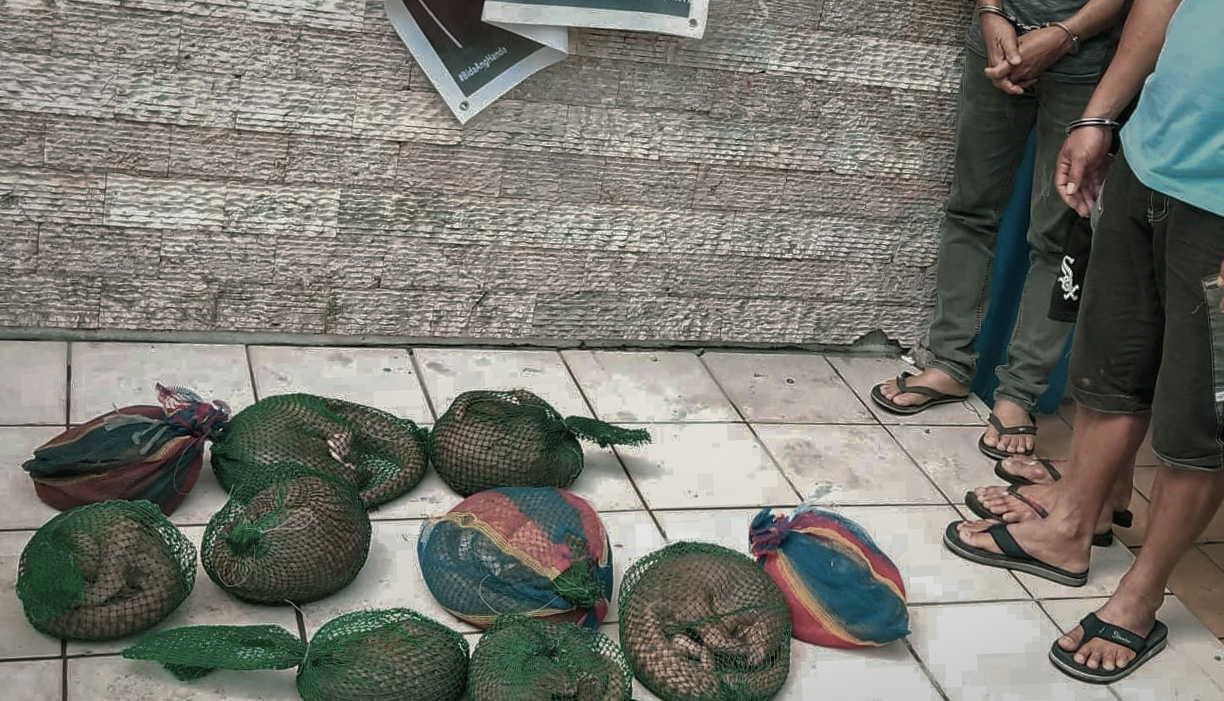
Ten pangolins seized by the Philippine authorities in Tagaytay City in June. 2019 Three men were arrested. © Department of Environment and Natural Resources, Philippines
Sy is one of the authors of a report that analyzed seizure data in the Philippines from 2001 to 2017. The report, published in 2018 by TRAFFIC, a global NGO working to investigate the wildlife trade, found 38 seizure incidents involving 667 pangolins. The figure is small compared with volumes reported elsewhere, but considering that the populations of Philippine pangolins have declined by more than 50% over 21 years, it is a significant number.
Sy said the seizure data they analyzed from different sources may just be “the tip of the iceberg.”
“The Philippine pangolin can only be found in the Philippines, in the province of Palawan, so the habitat is really small,” he said. “Any disturbance based on additional poaching and so on has a huge effect on them.”
TRAFFIC researchers believe that demand has increased over the past decade. One factor, Sy said, is the increasing demand, especially in Metro Manila, where pangolin meat is sold as a luxury food item and its scales are sold for traditional medicine.
The three men who were caught in Tagaytay City smuggled the 10 pangolins out of Palawan for illegal trade in the capital.
But Sy explained that domestically, most people who consume pangolin meat are still foreigners “because [Filipinos] don’t have a tradition of eating pangolins.” Some locals also consume it, he said, but only when they happen to encounter it, as they wouldn’t intentionally look for it.
“The Philippine pangolin can only be found in Palawan, so the habitat is really small. Any disturbance based on additional poaching has a huge effect on them.”
Pangolin meat can sell for US$3 to US$5 per kilogram, while scales sell from US$130 to US$190 per kilogram. Meanwhile, the TRAFFIC report said that in Metro Manila, live or frozen pangolins and cooked pangolins sell for US$233 and US$272, respectively.
“The poachers, the ones who hunt the pangolin, are usually Filipinos. The middlemen, those who go to the communities to ask them to hunt, could be either Filipinos or foreign nationals. The middleman will then pass it on to the wholesalers or the consolidators, who could be either a Filipino or a foreign national. That consolidator could be the one to sell the pangolin directly, or there’s another layer from another location, for example, in Metro Manila. From that point, that goes directly to the buyer,” Sy explained.

The majority of seizures occur around Palawan, and in the Metro Manila area, where there is increasing demand for its meat and scales. Data: TRAFFIC
However, as Sy pointed out, those in the “lower levels” of the smuggling chain – the poachers and traffickers – are often the “sacrificial lambs” who get arrested by law enforcement.
Data from the Palawan Council for Sustainable Development (PCSD), the agency mandated to implement the Philippines’ wildlife law in the island province, showed that 33 people were arrested in relation to the illegal pangolin trade from 2010 to 2018. At least 16 criminal cases were filed during the same period.
“We have to find the ones who order the hunting, those who finance it. Because if you don’t arrest them, poaching will never end,” Sy said.
In 2016, the Philippines proposed uplisting the Philippine pangolin to Appendix I of CITES (Convention of International Trade in Endangered Species of Wild Fauna and Flora). The government proposal said that the Philippine pangolin is “threatened with extinction and is detrimentally affected by international trade and habitat loss,” and that it “has been documented in international trade with China and Malaysia, and possibly with Vietnam.”
The 2018 TRAFFIC report, meanwhile, said that international trade routes could not be determined from the seizure data that the authors analyzed because “many of the records are without background information aside from the location of seizure and type and quantity of pangolin parts seized.”
“Foreign nationals (for example from mainland China and Taiwan) residing in the country have also been implicated in several seizures,” the report said, adding that it remains uncertain “whether this feeds a local market catering to visitors and/or foreign nationals residing in the country or an international market.”
Sy pointed out, however, that local demand for pangolin scales used in traditional medicine is not as significant as overseas demand. “The demand is mainly in China and Vietnam, where the scales are used,” he said.
“We have to find the ones who order the hunting, those who finance it. Because if you don’t arrest them, poaching will never end.”
With all these challenges on multiple fronts, there is still much to be done. There is also a lack of public awareness about the Philippine pangolin, which is considered one of the least studied species of pangolin.
In 2018, different conservation groups in the country came together and designed a 25-year roadmap for the conservation of the Philippine pangolin. The PCSD will conduct a study to identify the population strongholds of the Palawan pangolin, with the end goal of declaring these areas as critical habitats for further protection.
Here in the remote jungles of India’s Manipur State bordering Myanmar, the pace of life can often feel languid. The forests have grown back where British and invading Japanese troops once engaged in hand-to-hand combat in World War II.
Amidst the lush hills is Churachandpur, a typical border town where shops – selling cheap Chinese clothing and other hardware – spill out onto the monsoon-drenched streets.
But the outward calm hides a lively underground economy run by wildlife traffickers and arms smugglers.
“There is hardly anything that you cannot get in Churachandpur,” said a field officer from the Wildlife Crime Control Bureau (WCCB) who requested to remain anonymous, “from rhino horns to pangolin scales, or geckos to arms and ammunition.”
Churachandpur’s notorious reputation stems from its location on the border with Myanmar, but most of the wildlife ends up in China.
India shares a porous 1,600-kilometre border with Myanmar. Not surprisingly, these states are common routes for illegal trafficking networks involving wildlife smuggling, drug syndicates and the occasional militants.

Churachandpur, a border town between India and Myanmar. It is known to authorities as a smuggling hotspot for drugs, firearms, and wildlife including pangolins.
“Sometimes, drugs are also traded with animal parts. Drugs are pushed in through these routes to the Indian side with the help of militant outfits that frequent these routes,” a retired Manipur police official told us.
The militants in India’s northeast are also a source of arms and ammunition for smugglers in the region, we were told.
“The buyers normally come to Churachandpur or Dimapur in Nagaland,” said an undercover wildlife agent. He is part of a special investigation team set up by the state government in 2008 to stop rhino poaching.

Most of the pangolins smuggled through India are destined for Yunnan, China, through Myanmar.
Not too long ago, rhino horns and tiger parts were most heavily trafficked through these routes, but increased global attention has reduced demand in China. Now, pangolins and other wildlife have taken their place, investigators said.
“This network first smuggled rhino horns, but it has diversified into pangolins, geckos and other wildlife,” said the agent, who has conducted regular sting operations.
“There is hardly anything that you cannot get in Churachandpur, from rhino horns to pangolin scales, or geckos to arms and ammunition.”
“We have in recent times been able to stop the poaching of one-horned rhinos and smuggling of its horns,” said a WCCB spokesperson. “But we have noticed a sudden rise in seizures of pangolins from the region.”
“The recent increase in rescues indicates that there is a racket in smuggling out pangolins,” says Rathin Barman, joint director of the Wildlife Trust of India and head of the Centre for Wildlife Rehabilitation Conservation (CWRC).
But the numbers of captured animals are still small. WCCB officers have confiscated 10 live pangolins in the past three years from northeast Indian states. The Assam State Zoo is caring for pangolins rescued from traffickers between January 2007 and July 2019.
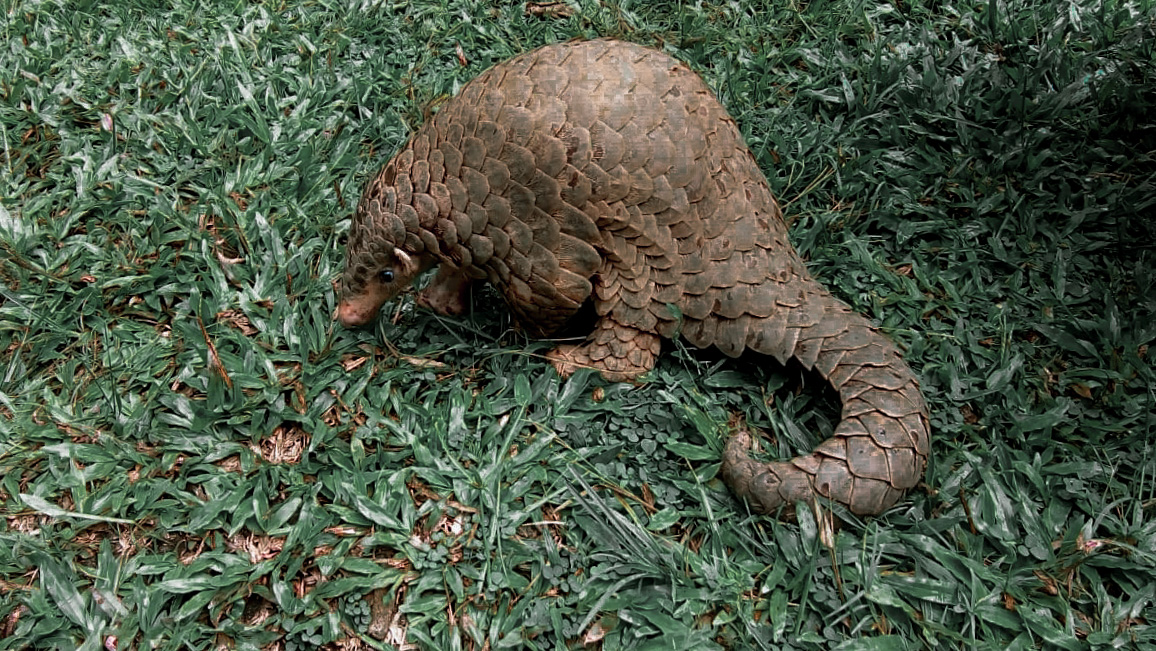
A rescued pangolin at the Centre for Wildlife Rehabilitation and Conservation near Kaziranga National Park in Assam, India. © Dauharu Baro / Wildlife Trust of India / International Fund for Animal Welfare
An additional 10 pangolins were also recently rescued from traffickers, who abandoned them to evade a dragnet operation by law enforcement agencies. In August, the CWRC found a dead pangolin in an abandoned bag at a bus stop in Upper Assam.
India, while not a consumer of pangolins, is a source country for Indian and Chinese pangolin subspecies. Farmers, traditional snake-charming communities like the Sapera, and the semi-nomadic Bawariyasin often sell the animals to the middlemen for up to 70,000 rupees, a local fortune that equals roughly US$1,000, the wildlife officers said.
The pangolins are then taken to Manipur State and smuggled across the border to Myanmar, and on to China, the officers said.
Pangolins are not the only Indian native animal facing massive threats to their survival. The tree-dwelling tokay gecko – erroneously believed to be a cure for cancer and HIV/AIDS, and said to fetch prices of up to one million rupees – is also being smuggled into China via the same routes.
“Even though the animals have protection status, rhinos and tigers get all the attention,” said the Assam-based conservation activist Baibhav Talukder. “The punishment for poaching of rhinos and pangolins are similar, but our law enforcement agencies weren’t as concerned about pangolins until recently.”
“Wildlife trafficking should be seen as a national security threat and not merely the smuggling of animals,” he said.
In March, two men aged 40 and 34 were intercepted at Tribhuvan International Airport in Kathmandu carrying 162 kilograms of pangolin scales in their check-in luggage.
The pair had picked up the scales in the Democratic Republic of Congo, transited in Istanbul, then attempted to transit again in Nepal on their way to Shanghai. They are now at the Nakkhu Jail on the outskirts of Kathmandu, where they are awaiting trial.
Their arrest was a watershed moment: It was the largest recorded seizure of pangolin scales in Nepal and the first haul from an African pangolin species. It led police to worry that Nepal has become a new transit point for pangolins heading to China.

Two Chinese nationals smuggled 162 kilograms of pangolins scales via commercial flights from the Democratic Republic of Congo, to Istanbul, to Kathmandu, where they were arrested. They wanted to travel to Shanghai, China.

Two Chinese nationals smuggled 162 kilograms of pangolins scales via commercial flights from the Democratic Republic of Congo, to Istanbul, to Kathmandu, where they were arrested. They wanted to travel to Shanghai, China.
Information extracted from their mobile phones revealed that they were communicating with Chinese wildlife smugglers via WeChat, a Chinese messaging and payment app. Investigations identified a Nepali, a Bangladeshi and a Chinese accomplice. The three are still at large.
“This is a distinct case of international organised crime, but it is just the tip of the iceberg,” said Birendra Johari of the Nepali police’s Central Investigation Bureau. “Our investigations show that pangolins in recent times have become the most poached wildlife in Nepal.”
Although Nepal lies on the traditional wildlife smuggling route between India and China, it has so far avoided the large-scale seizures seen in places like Singapore, Vietnam and Hong Kong. The bulk of arrests to date involve small amounts of locally poached pangolins with no apparent connections to larger syndicates.
However, experts say they are concerned that this is changing. One reason is improving infrastructure.
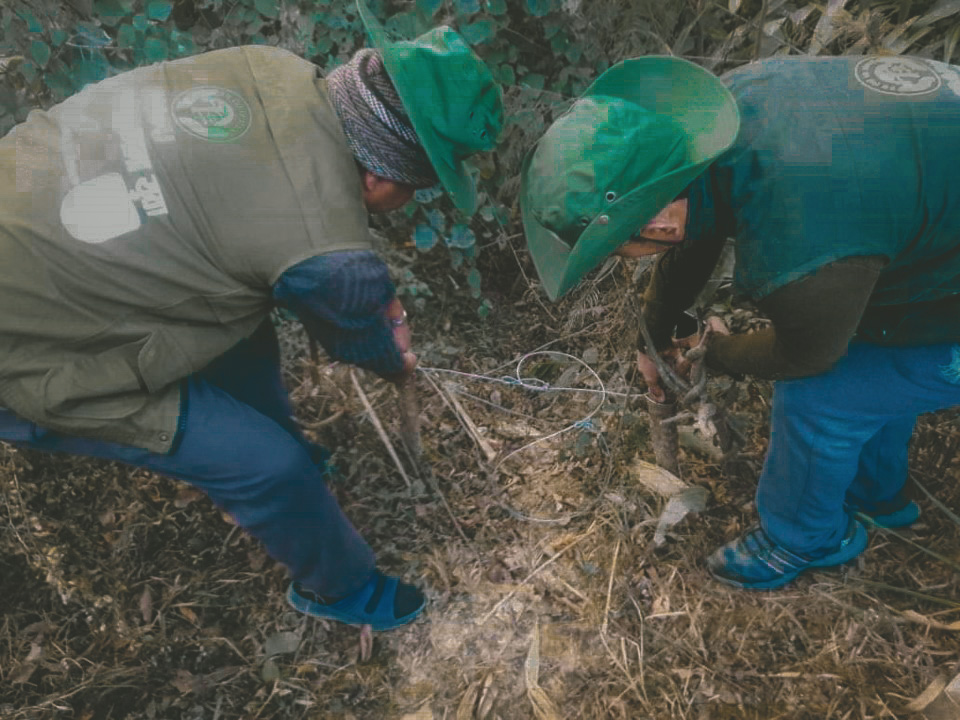
Members of a community-based anti-poaching unit removing animal snares in Kavre district, Nepal. Nepal has not recorded any major busts so far, but wildlife law enforcement experts say that pangolins have become the most poached wildlife in the country in recent years. © Zoological Society of London / Himalayan Nature
The reopening of the Tatopani-Kodari border crossing with China earlier this year after it was destroyed during the 2015 earthquake, the increasing use of the Rasuwa-Kerung border crossing, and the prospect of a new trans-Himalayan railway line could all make Nepal a more attractive transit point for traffickers. Police in the Dolakha district, bordering China, also speak of rising demand that has led to the near disappearance of the animal.
“Nepal is already a signatory of China’s Belt and Road Initiative, which could increase market access and trafficking of wildlife,” said Kumar Paudel of Greenhood Nepal, a conservancy group, adding that pangolins from Africa, India and Bangladesh were already being intercepted in Nepal en route to China.
Just five months before the arrest in Kathmandu, there was an almost identical case, in which two Chinese nationals were arrested smuggling suitcases full of pangolin scales from Congo.
Except this arrest was made, not in Nepal, but in Hong Kong.
Hong Kong has been a hotspot for shipping pangolin scales since 2014, with tons of container shipments seized from Africa, and smaller seizures by speedboat and individual smugglers arriving by air.
Although Traditional Chinese Medicine still plays an important role in the territory – there are more than 7,100 licensed TCM medicines traders here – local dealers we met undercover told us that they were not interested in large amounts of scales because the local demand was just too small.
“The risks (of selling scales) compared to the profits are too high. It’s not worth it,” a shop owner told us, “this business is better in the mainland.”
At the Lo Wu Correctional Institution, a prison, we found two small-time traffickers who were willing to discuss their actions.
The two Chinese women are serving time for attempting to smuggle some 110 kilograms of pangolin scales in four suitcases from Hong Kong International Airport to Macau by ferry, en route from the Democratic Republic of Congo.
One of them, aged 41, told us about her humble origins in China, her time in Congo, her plans to travel home to China and her arrest at the Hong Kong ferry terminal in August this year. Both are from the Guangxi region in southern China and asked not to be identified to speak more freely.
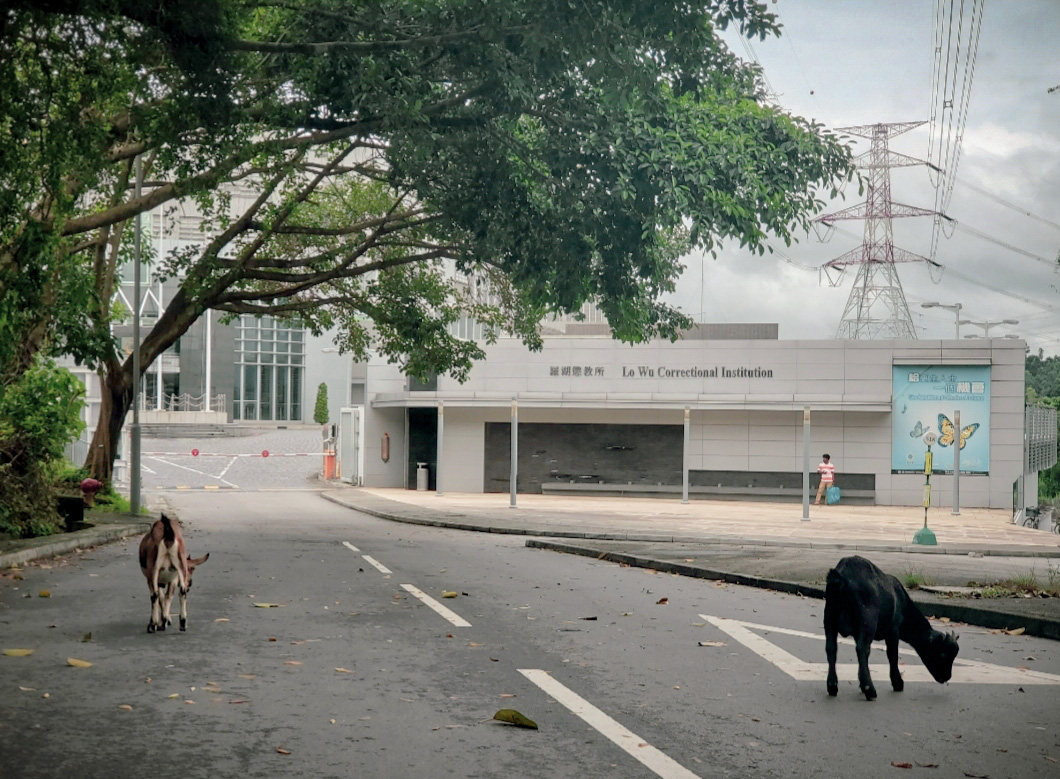
The prison where the two smugglers are being held. Credit: Karen Zhang / The South China Morning Post
They said that a man they called Li Guangsheng had invited them to Congo to invest in beauty parlours last year. Li ran a construction business in Kinshasa, the capital, they said. “I was told that there are a lot of Chinese there and business was good,” one of the inmates said.
Li hosted and provided for them during their one-month stay in Kinshasa from October to November last year, they said. Then Li supposedly asked them to take four suitcases to Macau, the gambling hub.
They flew from Kinshasa to Hong Kong through Casablanca, in Morocco, and Doha, a circuitous route they said was cheaper than a direct flight.
Their statements could not be verified, nor could contact information for Li be found.

In 2018, two Chinese women were arrested while bringing 110 kilograms of pangolin scales from Kinshasa, via Morocco and Qatar, to Hong Kong. Their destination was Macau, they said.

In 2018, two Chinese women were arrested while bringing 110 kilograms of pangolin scales from Kinshasa, via Morocco and Qatar, to Hong Kong. Their destination was Macau, they said.
The women were arrested at the Hong Kong International Airport while attempting to travel to Macau by ferry.
The women had been instructed by an acquaintance in Congo to pass the scales on to a stranger in Macau, they said. Had the trip gone according to plan, those four suitcases of pangolin scales would have travelled some 17,000 kilometres on commercial routes.
The two women were caught at Hong Kong airport during a routine customs X-ray check. Their suitcases contained the scales of 302 pangolins, at a total weight of 110 kilograms, wrapped in tin foil bags. Prosecutors later estimated that the scales could be worth as much as $71,000.
When we visited them in pre-trial custody before their sentencing, both women claimed that they did not know what they had been transporting. “We thought it was dried seafood,” one of them said.
They pleaded guilty and were sentenced to 16 months in prison for importing a protected wildlife product without a license.
The court heard the pair’s case after new legislation passed in November 2018, increasing penalties for pangolin trafficking. Now, the crime is punishable with a fine of up to 10 million Hong Kong dollars, or roughly $1.3 million, and up to 10 years in prison.
During a visit after their sentencing, one of the two inmates changed her story. She said that she knowingly trafficked pangolins, but said that they did not expect to be jailed.
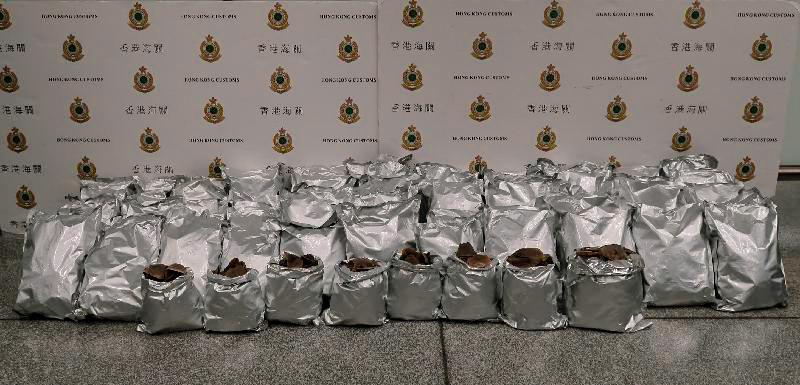
These are the 110 kilograms of pangolin scales wrapped in tin foil that the women tried to smuggle through Hong Kong to Macau. © Hong Kong Customs and Excise Department
Li told them about the scales, she said. “He said if we got caught, he would pay the fine and we would be fine,” she said. “We trusted him.”
“I heard that someone bringing ivory for him was arrested in Hong Kong before,” the inmate said, “but that the person was released after paying a fine.”
Their case is not the only one. In mid-November last year, a man from China’s Fujian Province was sentenced to 20 months in prison for smuggling 48 kilograms of pangolin scales from the Democratic Republic of Congo via Ethiopia to Hong Kong.
The two women are still serving time, spending their days washing dishes and cleaning floors at a prison kitchen. As soon as they are released, they plan to return home to Guangxi. “We will be sent to the border and then take high-speed trains to go home,” said one, with a wry smile.
On an early summer morning in the Vietnamese tourist town of Ha Long, we meet a man surnamed Chen at a bar that will soon turn to its daytime trades of milk tea and currency exchange.
Chen runs a restaurant, but also tries to earn additional cash by showing tourists around and smuggling ivory and pangolins. Born in 1988, he lives alone in a messy apartment on the outskirts of Ha Long. Chen showed three pangolin scales as samples of his trade to us (we were reporting undercover, feigning interest in buying scales). “You can wait at home in China, we deliver to your doorstep,” he said.
His prices depend on provenance. Asian pangolin scales go for 3,200 Chinese renminbi, or around $450, but African scales cost a mere 1,300 renminbi, or $180, per kilogram. Because of the legal risks, he only takes orders above 10 kilograms at those prices. For smaller orders, he would charge a premium.
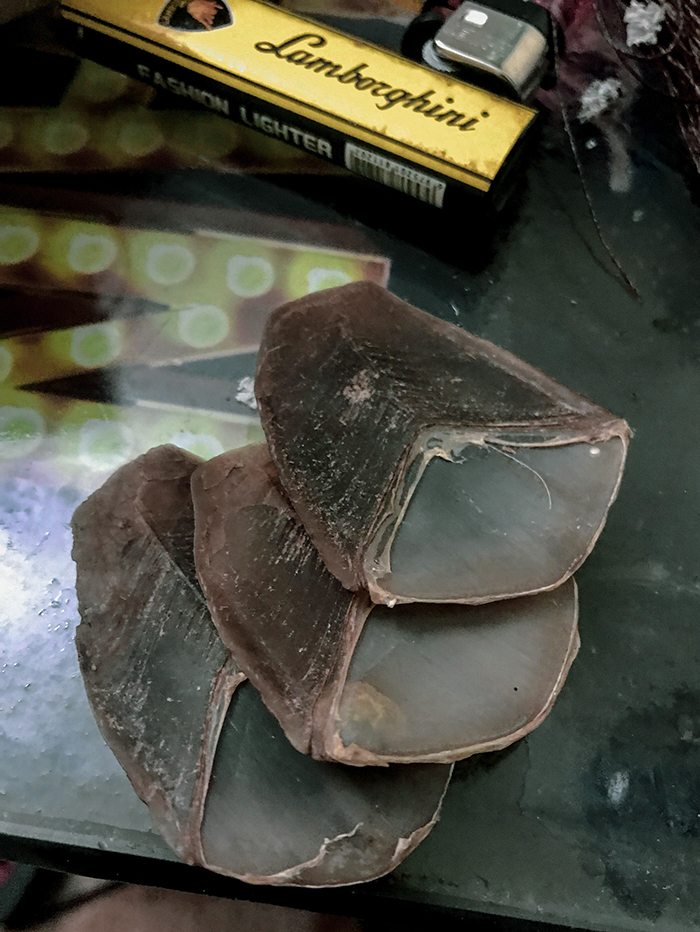
The pangolin scales Chen showed us as samples of his trade. An expert later told us that the scales came from an Asian pangolin.
His supply comes from Laos. But he claimed he did not know how they went from Africa or elsewhere in Asia to Southeast Asia’s only landlocked country. He boasted that once smuggled to China, his goods, which also include bear paws and ivory tusks, can be delivered across the country, except for the northeastern provinces. Estimated delivery time: four days.
There is an oft-used land route from Laos through Vietnam to China, according to our review of local media reports from 2011 to 2019. Over 3,000 live pangolins have been seized while being trafficked in a total of 44 seizure cases in the land route that extends from Cau Treo at the Laotian border to Móng Cái at the Chinese border.


Data compiled from media reports on pangolin seizures between 2011 and September 2019 show that almost 50 percent of all reported cases of busts in Vietnam took place along the highway connecting the Laotian border in Cau Treo to the Chinese border at Móng Cái. This suggests an established smuggling route.
The border towns of Dongxing and Móng Cái have become wildlife smuggling hubs for pangolin. Residents in these border towns can apply for a special day pass that allows them to cross the border with minimal checks. Investigations show that this often facilitates smuggling activities.
But trade is much bigger by air and sea cargo. Overall, police and customs have confiscated over 43 tons of pangolin scales and over 24 tons of frozen pangolins between 2011 and 2019, according to our review. Anecdotal evidence suggests that the majority of the bulk cargo originated from African countries, including Nigeria and Cameroon.
In our conversations, Chen mentioned the Chinese border town of Dongxing as a major smuggling hub, so we went there. The town, along with its sister town of Móng Cái in Vietnam, has flourished because of the border trade. The two cities are practically one, were it not for the heavy surveillance and fortifications that attempt to control and tax the bustling undeclared border trade.
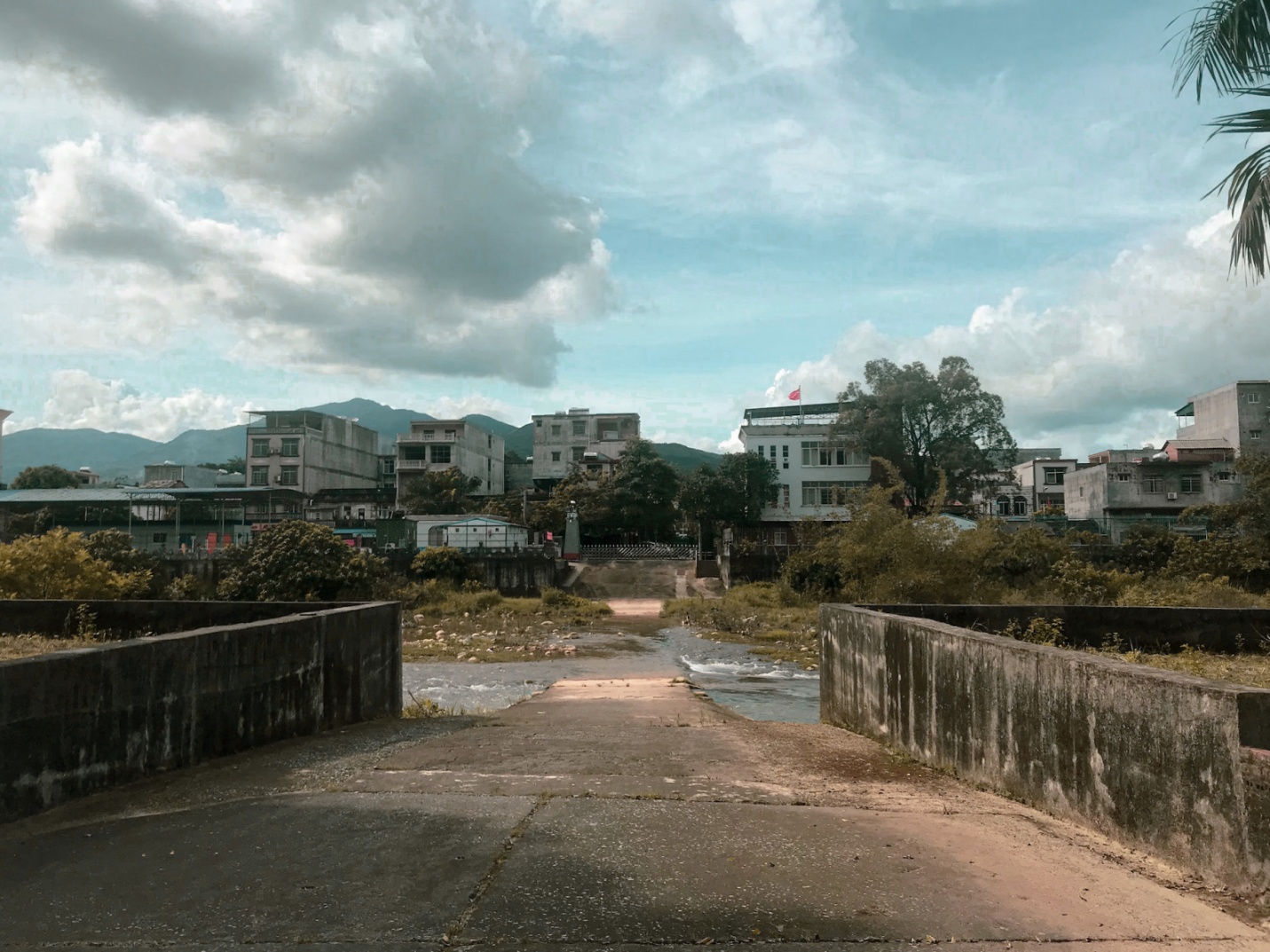
The town of Dongxing, China, can be seen in the distance from its sister border town of Móng Cái in Vietnam. Here, our undercover journalists discovered an active underground trade route in wildlife including pangolins.
It seems that the crossing of checkpoints here is a mere formality in lives lived on both sides. Residents in both towns said that they used special passes, allowing them to cross the border with minimal checks, as long as their stays were brief and limited to the border area.
On the Vietnamese side, we met Hoang Anh, a taxi driver who previously made a living peddling iPhones bought in China. He showed us a photo of himself with his brother and seven pangolins.
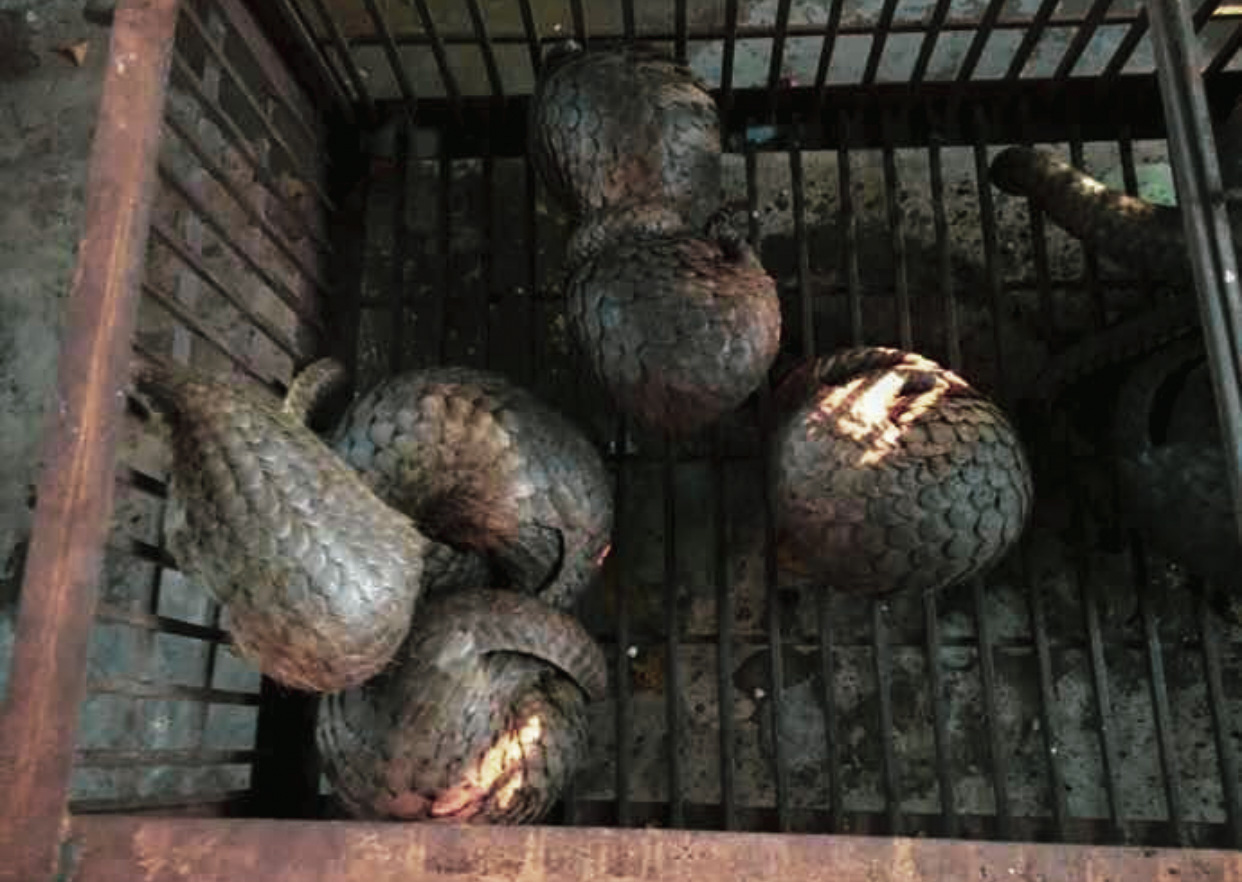
A screenshot of a WeChat post by Hoang Anh, a taxi driver who is also running a side business illegally trading wildlife in Móng Cái.
The photo, dated June, was meant to prove that he could supply the animal at its freshest: alive. His buyers, he said, were mostly people interested in pangolin meat for special meals.
The going rate for pangolins is 1,250 renminbi per kilogram, which brings a live animal of about five kilograms to 5,000-6,000 renminbi. He said that thanks to bribes and connections, delivering to China would not be a problem.
Deep in Taiwan’s Luanshan forest in the dark of the night, Yu Man-jung spotted some tracks on the ground. “There was a pangolin just here,” Yu pointed out to the team of researchers behind him. Yu, also known as A-yung, moved quickly in the pursuit of more traces. He had developed a keen eye for spotting any signs of the shy scaly anteater over the years in his former career as a poacher.
Before he started working with pangolin researchers at National Pingtung University of Science and Technology (NPUST), Yu was poaching pangolins for a living. That was years ago, before pangolin researcher Hsun Ching-min hired Yu to help track the animal for research. For Yu, the new income helped offset the loss in revenue caused by stricter controls and falling domestic demand in pangolin meat.
A native of the mountainous terrain, Yu had spent much of his life around pangolins. The knowledge of the forest and his instincts for finding the reclusive animal have since been credited by researchers for several significant successes in the field.
“If not for A-yung, I wouldn’t have known where the pangolins were,” says Hsun admiringly, using Yu’s nickname. “He was always a trailblazer in the pangolin patrol team.”
“Without a local to lead the way, we would not have been able to find pangolins, no matter how advanced our technology is,” said Hsun.
Yu passed away in 2016 in an accident. However, his contribution to pangolin research and conservation is not forgotten. Hsun is leading ongoing research in Luanshan, Taitung, to better understand wild pangolins and their consumption habits.
Pangolin research can be hard work, involving many – mostly unsuccessful – hours of tracking, analysis of food sources, and even stool-sniffing.
Hsun, who has tracked down 47 wild pangolins in eight years of research, jokingly calls himself “the man who has collected the most pangolin faeces in the world.”
“Without a local to lead the way, we would not have been able to find pangolins, no matter how advanced our technology is.”
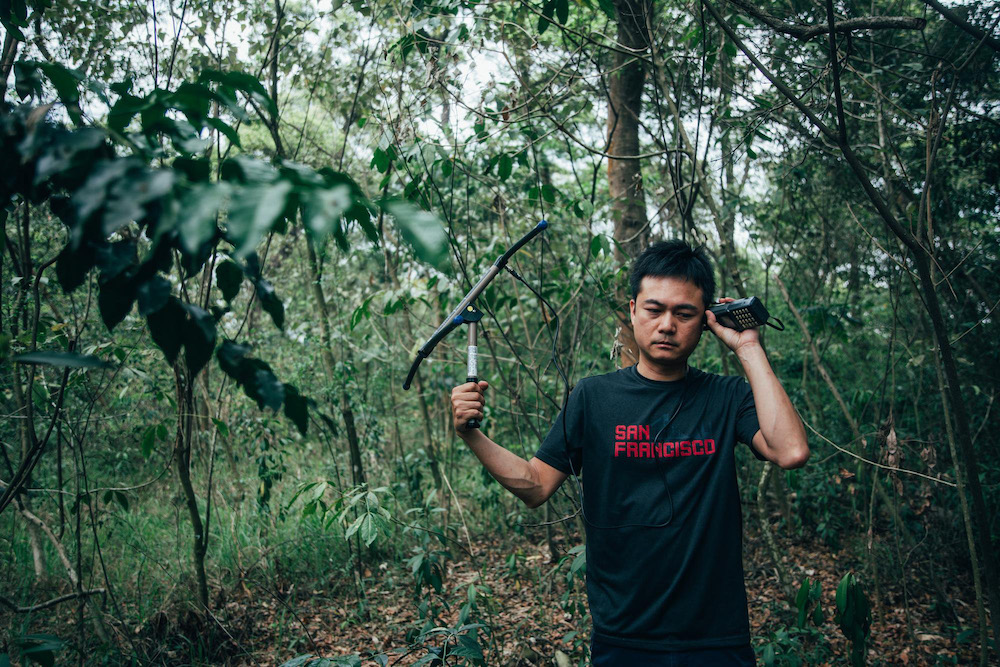
The pangolin researcher Hsun Ching-min has spent eight years trekking down wild pangolins to learn more about the shy, reclusive animal. Credit: Tsai Yao-Cheng / The Reporter
Studying pangolin compost and stool are essential indicators of the animal’s nutrition. But the stool is hard to find. Pangolins only excrete once a day. They bury their faeces to cover their tracks, which makes it difficult for researchers like Hsun to collect stool samples.
Hsun developed and patented a technique to segregate pangolin stool components, and worked with the Taipei Zoo to further analyse the volume and digestive rate of different ant species in pangolin stools.
Pangolins are notoriously difficult to care for in captivity, and rescued pangolins frequently die from stress and failure to eat. With Hsun’s research, NPUST hopes to learn more about pangolins’ eating habits to improve the survival rates of future rescues.
Taiwan today has become a success story in pangolin conservation, but things were different just half a century ago. From the 1950s to the 1970s, Taiwan exported nearly 60,000 pangolin leather pieces every year. As a result, pangolins almost became extinct.
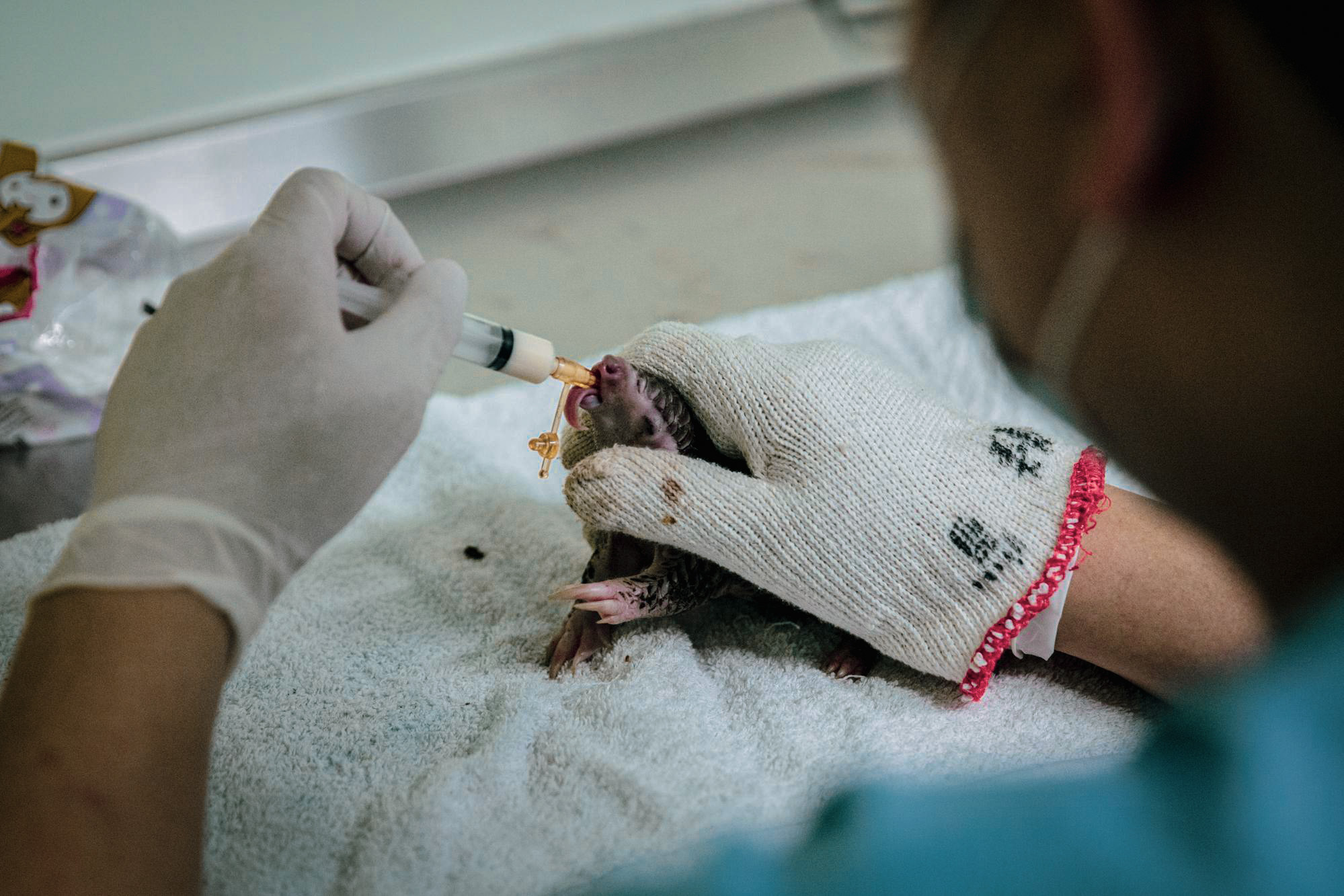
A newborn pangolin was manually fed at the Endemic Species Research Institute First Aid Station, which is one of the three pangolin rescue centres in Taiwan. Credit: Yu Chih-Wei / The Reporter
It was only in 1989 that commercial hunting and export were banned after the government established the Wildlife Conservation Act. Today, the population density of Taiwanese pangolins is one of the highest in the world.
While legislative reform and public awareness have mostly ended the illegal trade, Taiwan remains a smuggling transit point to mainland China.
Just last year, Kaohsiung customs officials intercepted 3,880 descaled and disembowelled pangolin bodies in a container that originated from Malaysia. In another notable seizure, the Coast Guard Administration seized five Taiwan pangolins, along with Asian yellow pond turtles and yellow-margined box turtles in 2015.
These, too, were all believed to be en route to mainland China.

In January 2018, a shipping container was found with 3,880 descaled and disembowelled pangolins at Kaohsiung Port. According to a source at the customs department, the shipment was believed to have originated in Kuching, Malaysia, and was likely en route to mainland China.
Today, Hsun has honed his skills at finding wild pangolins, although he admits that he mostly relies on luck. We hiked with him up a mountain along the same route that Yu, the former poacher, used. An hour into the hike, we found an old burrow buried underneath a pile of leaves and weeds.
An indigenous resident of the area pointed to a nearby slope. “There’s a burrow and it’s quite new,” he said. We crawled on all fours, holding onto the bamboo to keep our footing, until we spotted the deep underground burrow. It had the fresh remains of a palm-sized ant mound next to it, the remnants of a pangolin's feast.
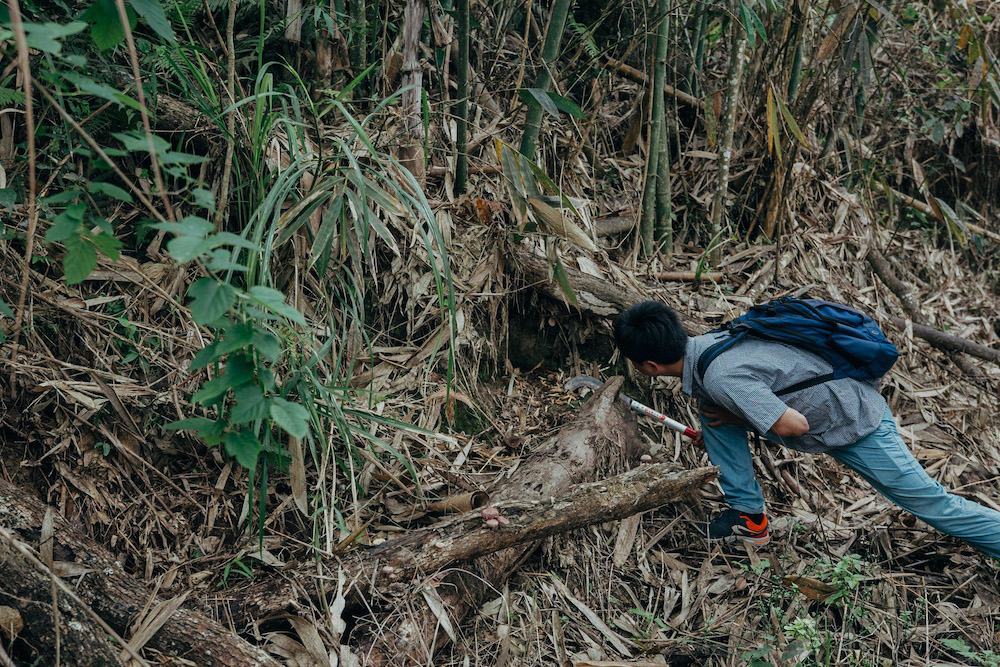
Pangolin researcher Hsun Ching-min examining a pangolin burrow. He relies on local guides to look for the animal, which he studies to improve the survival rates of future rescues. Credit: Tsai Yao-Cheng / The Reporter
Hsun marvelled at our good luck. Our find was a rare one. “This burrow was dug only in the past two days,” he said. “It usually becomes mouldy after that.”
Hsun suggests that the government should employ residents like Yu as guides or ecological conservationists. It should utilise their knowledge and skills to push for even higher conservation goals.
“Perhaps, we can even make Luanshan a world-standard pangolin conservation centre,” he said.
We’re back in mainland China. In April, we found five pangolins at a zoo in the southern city of Guangzhou, Guangdong Province. They had been seized in a sting operation on smugglers in a nearby town a few weeks earlier. The provincial forestry administration ordered them temporarily housed at the zoo. They ended up in a cage formerly used for lizards.
The origin of the animals remains unknown, but officers said that the animals had been taken to China through Vietnam and then to Meizhou, a southern town about 400 kilometres east of Guangzhou. Customs officers seized a total of 103 pangolins in the bust. Of these, 82 were taken to Guangxi region and 21 were kept in Guangdong. Most of these 21 pangolins died shortly after that.
The China Biodiversity Conservation and Green Development Foundation, an advocacy group, dispatched a staff member, Sophia Zhang, from Beijing to Guangzhou to care for the remaining animals.
At the zoo, Zhang set up a live camera and shared updates on Weibo, China’s Twitter-like social media platform, to bring the animals’ plight to the attention of possible donors. Volunteers in Yunnan Province, which borders Myanmar and Laos, collected and froze ants for Zhang and had them delivered to Guangzhou to feed the animals.
Despite her best efforts, two animals died in April, leaving only three survivors. Veterinarians from a nearby pet hospital and vet students from a local university volunteered to help Zhang prepare their food, using chopsticks to loosen the frozen ants, and clean their cages. “I’m happy they eat well,” she told us. “Pangolins are like humans when under shock.”
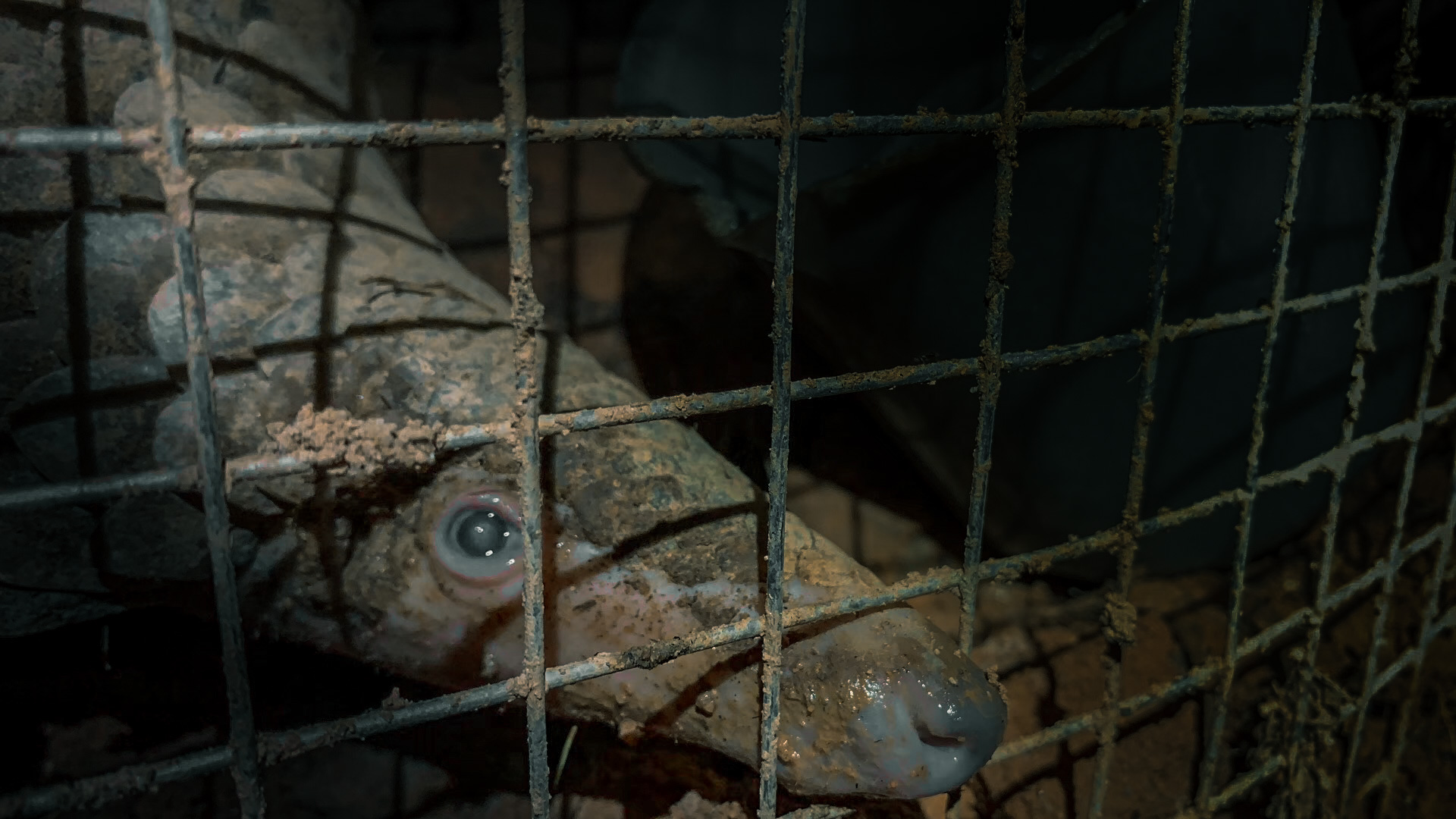
A pangolin rescued in a sting operation in Guangzhou, China, earlier this year. A veterinarian who has been caring for her said the death of a fellow rescued pangolin had incurred anxiety in the remaining pangolins. © Sophia Zhang
The three pangolins were trailblazers. It is the first time in China that the authorities allowed a non-law enforcement, non-profit organisation to assist in the care of a seized animals, a spokesperson for the foundation said.
The foundation has been jubilant. It had been pushing for access to seized pangolins since 2017. Last year, it even filed a lawsuit to get access to another batch of 32 confiscated animals. The case is ongoing. Perhaps these three pangolins could set an example for the court case and future cases.
The zoo proved to be only a temporary home. By May, the foundation found a space in Qingyuan, a nearby town, where the animals could be slowly released into a state of near freedom.
A real estate company had secured a green space of several hundred square meters that is encircled by its residential buildings. There was enough space for the animals to live on relatively peaceful terms. It would be the first release of seized pangolins into semi-wild conditions in China, the foundation said.
After a few days, the pangolins began to become familiar with their new environment. They began to dig for food and appeared to be developing an appetite.
But one was struggling to breathe and moved more slowly.

Customs officials in China rescued this pangolin from smugglers in early 2019. She later died, despite best efforts by volunteers and veterinarians. Credit: Handout
As its condition deteriorated, volunteers put the animal in a box and rushed it to the animal hospital in Guangzhou. By the time they arrived, the pangolin was declared dead.
The real estate company’s staff lack the experience Zhang has in taking care of the remaining two pangolins. The two survivors have been struggling with anxiety since the death, she said.
In June, the foundation asked the government to take the two animals back into a shelter or allow for their release into the wild. On July 3, they were picked up by officials from the forestry administration.
It is unclear what happened to the two animals. The bureau declined to comment.